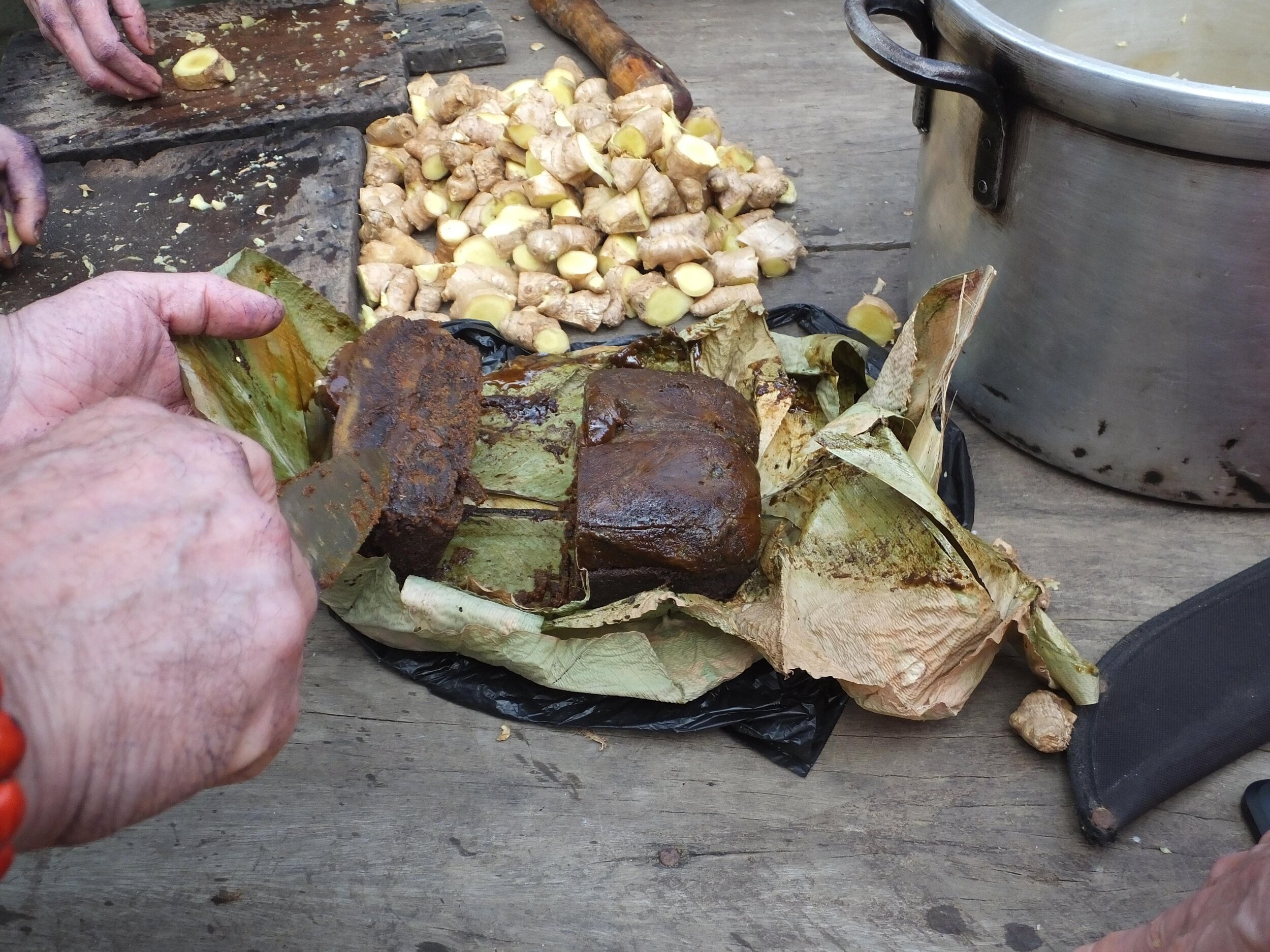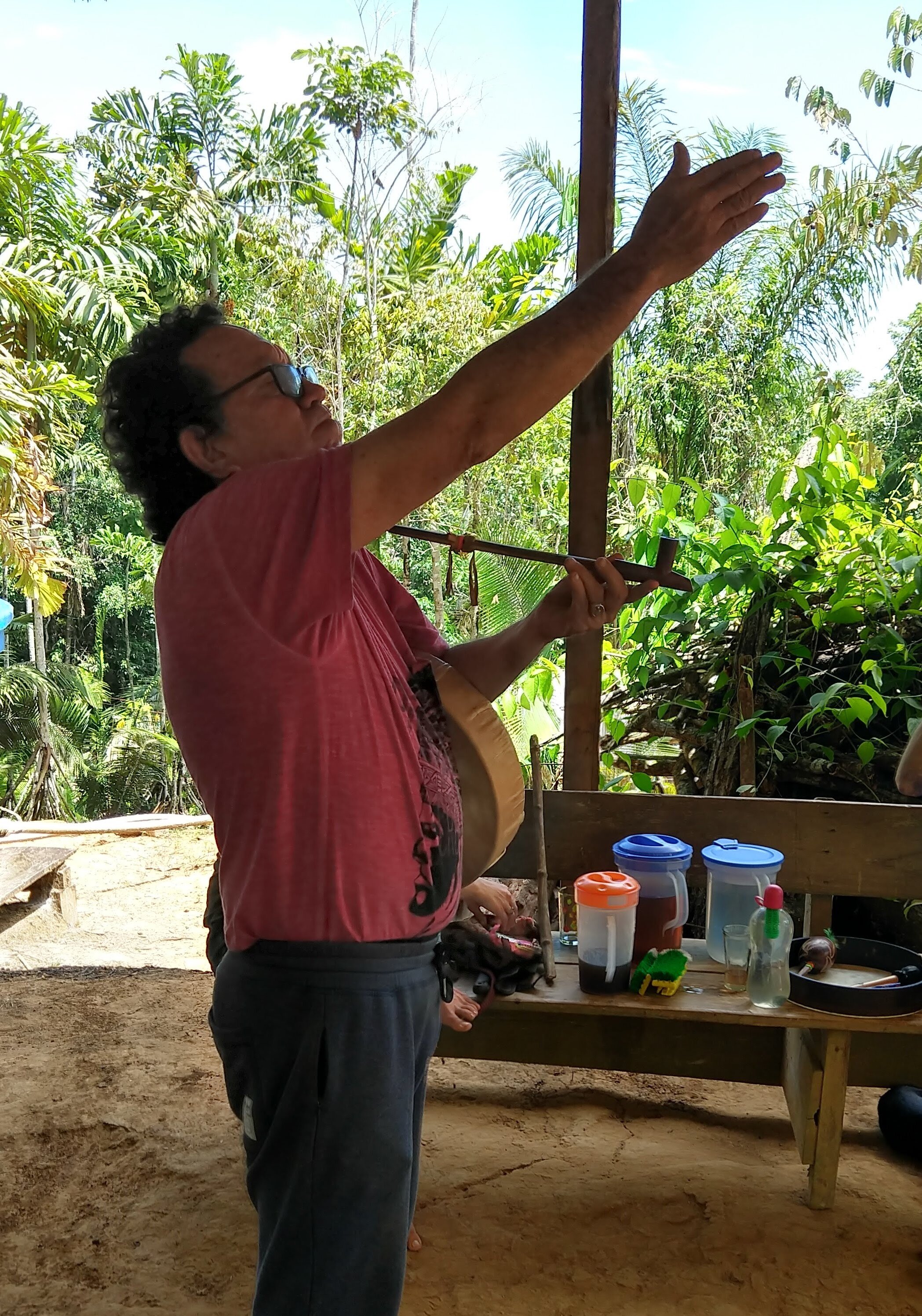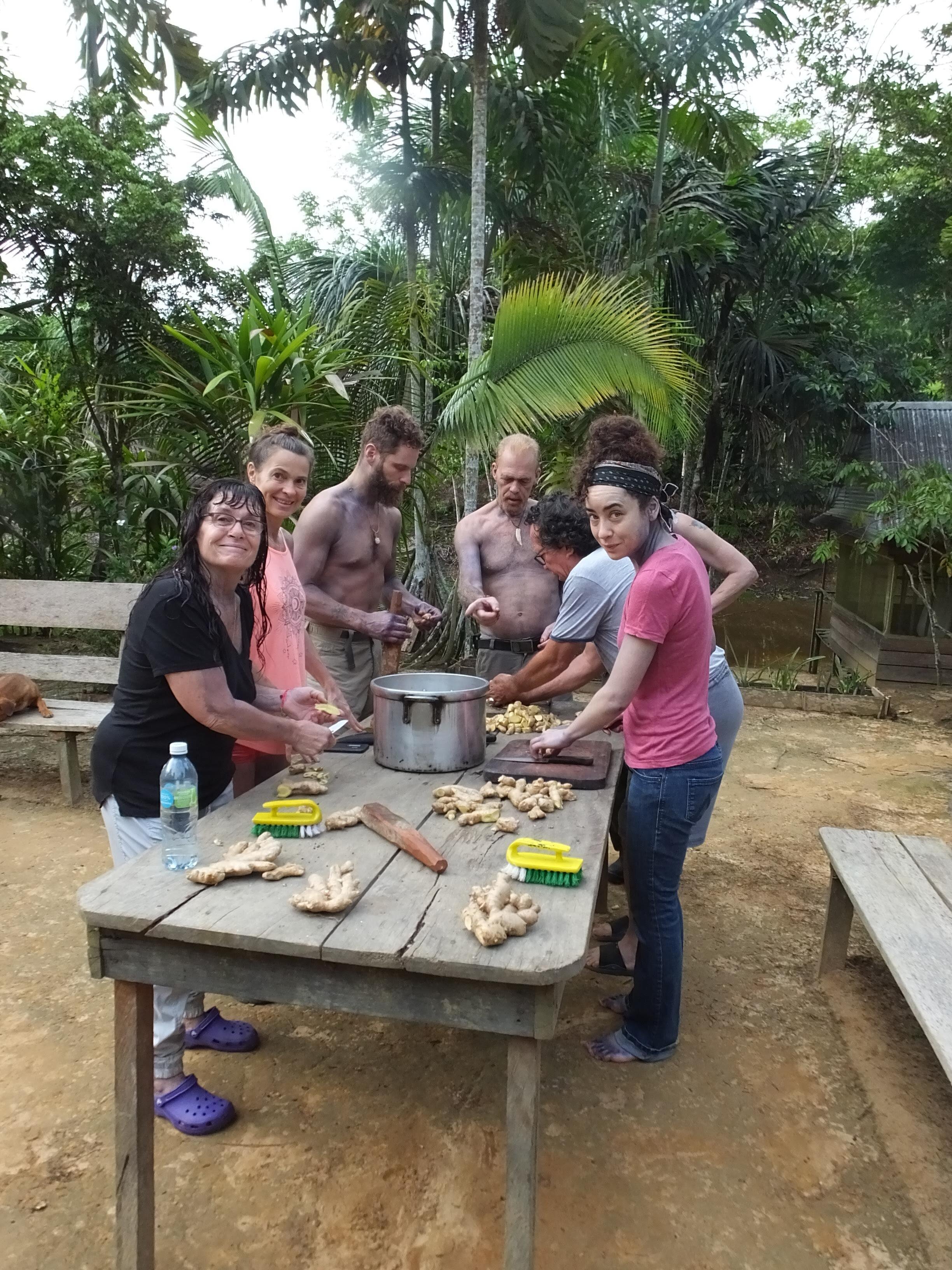This trip was originally supposed to run from March 7th to March 20th 2020, but due to the Covid-19 Pandemic, was extended a bit. The details follow…
This trip began much as most others, with some people, including myself, arriving the night before and the rest arriving on the morning of Day One. This time around we had six travelers plus myself, a smallish group, but all with some experience in shamanism and most known to me. The pre-trip preparation went well and I had high hopes for this group, expecting the experience would be a powerful and memorable one for them.
The group seemed well prepared and I was hoping for everything to go smoothly, because after all, this was the trip that had first inspired me to do this work decades ago. Little did I know…
At the Lima Airport shortly before our departure for Iquitos
After our breakfast and room checkout, we made for the domestic departure gate, cleared security and made it across the tarmac to our plane, which had a few foreigners aboard, but was mostly Peruvians. As expected, it did not depart on time, but that wasn’t going to be a problem because we were scheduled to arrive in Iquitos before Viejo, our host shaman, got there anyway.
We took off about 30 minutes late and expected to cover the 600 miles of mountains and jungle in just over two hours. That expectation changed however when the view outside the window began to show ocean instead of mountains, and the ocean was on the wrong side of the plane! It was shortly apparent that we were dropping in altitude as well. Being a flight of mostly Peruvian Nationals, the flight crew didn’t think to make an announcement in English, so it took a few minutes to find out that a warning light of some kind had illuminated in the cockpit, so we were taking an emergency flight path back to Lima to straighten things out.
We landed safely, remained on board and the ground crew set about either making a repair, or disabling the warning light, I never learned which, and we were on our way again in just over an hour. By the time we landed in Iquitos, it was mid-afternoon. There was just enough time to check in to our hotel, shower, see a little of the main square and meet up with Viejo, Nina, his partner and Lilia, our translator from the Andes for dinner. Dinner was at a restaurant that has a menu that caters to our Ayahuasca diet, or ‘dieta’. It was a very nice meal considering our restrictions and we also had some time to spare afterward to get a taste of the local culture.
We were up early to meet our boat at the dock and were soon on our way to Tamshiyacu, the village near the shamans camp where we would be spending our visit.
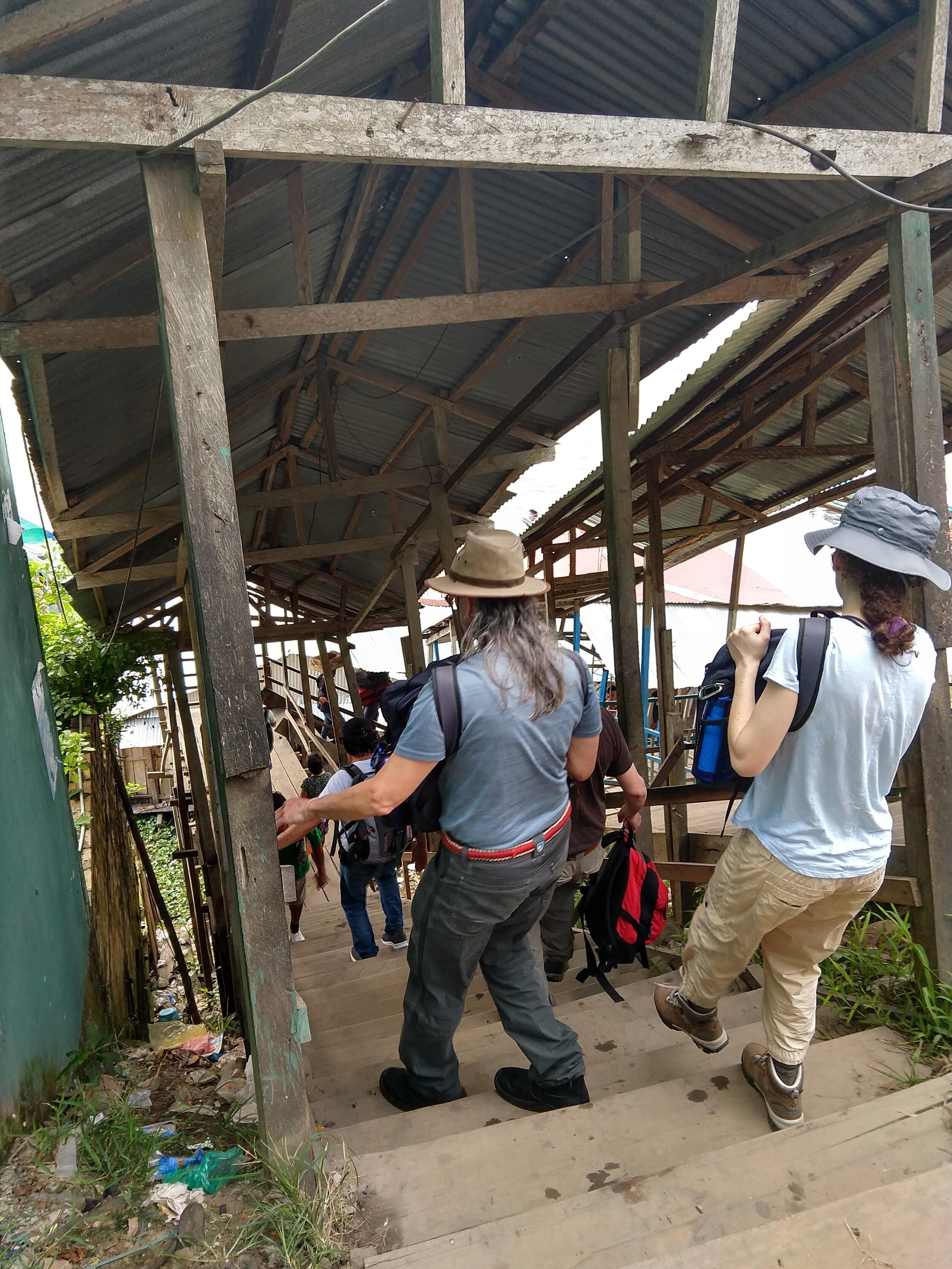

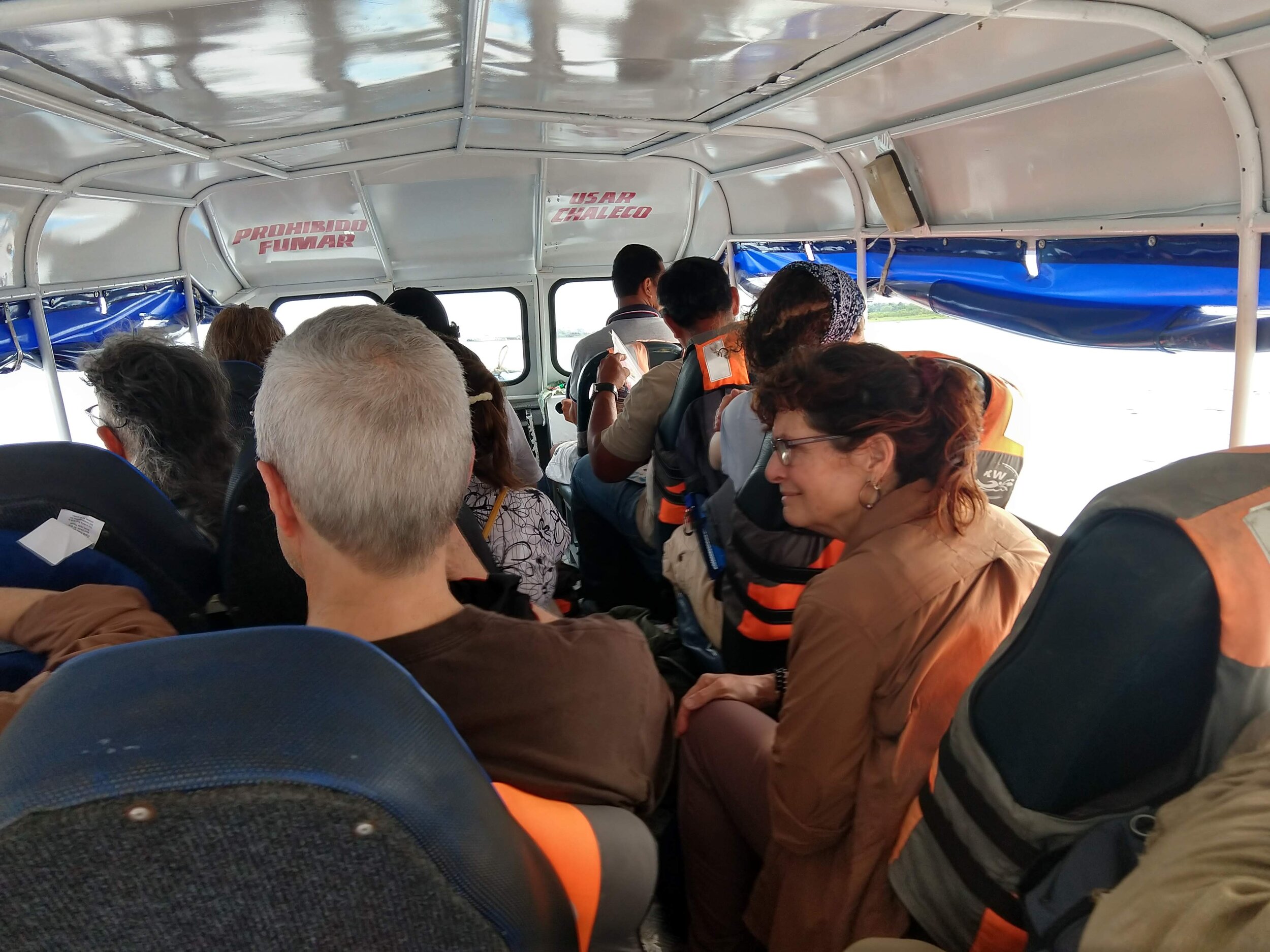
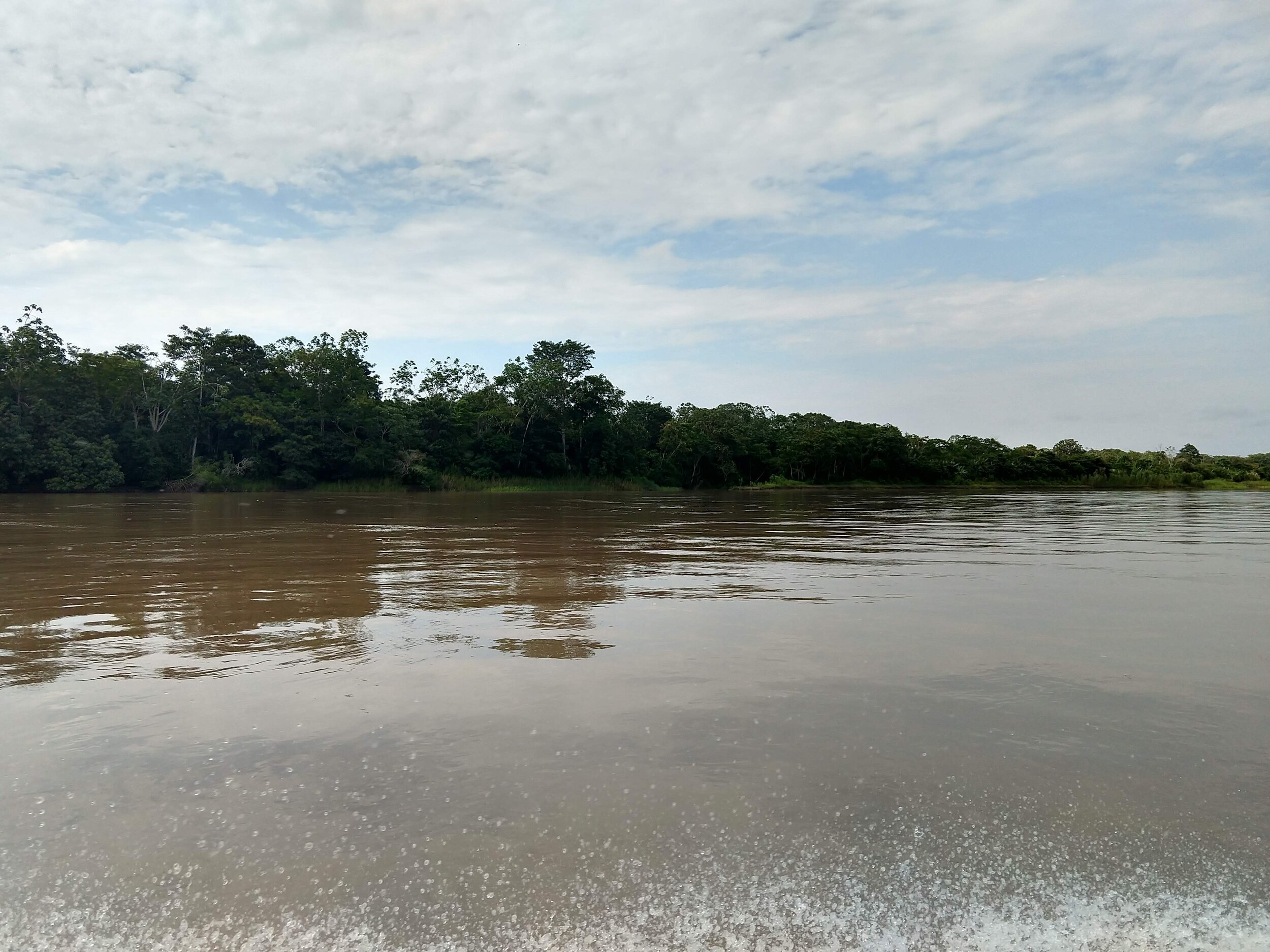

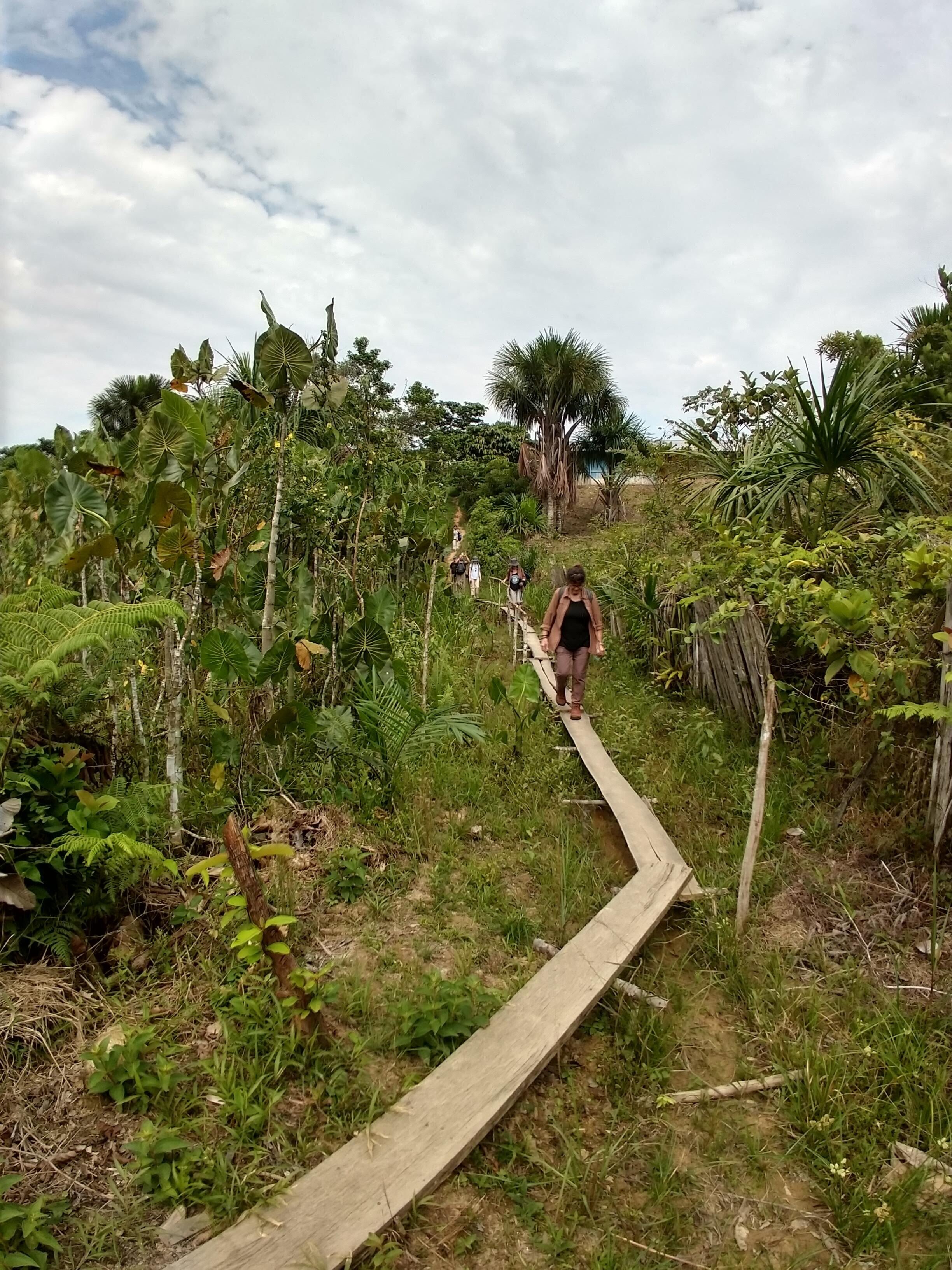
Tamshiyacu is the home village of don Agustin Rivas Vasquez, my first teacher in the Amazon. At 97 years young, he still maintains a camp, Yushintaita, in the jungle a few kilometers from town. Our Stay would be at his son Viejos camp, Supay Chakra just on the outskirts of the village. On our first day, we were honored with a brief visit from my old teacher joining him in song and drumming. Viejo and his partner Nina Caspi, would be our hosts for the next two weeks, or so we thought at the time. The Nation wide Covid-19 Corona Virus quarantine would change our plans, but at the time we had no idea what was in store and settled in for our long awaited retreat.
After unpacking and having a brief rest we were welcomed to the camp with a traditional herbal bath, dinner and finally the Huito Ceremony. The huito fruit, which is grated into a pulp, when applied to the skin, turns it a deep blue black overnight and stays with you for several days. You can see the effects below.
This first night together also gave Viejo and Nina a chance to chat with the group and get to know those of us they had not yet met. The group had the opportunity to ask questions and become comfortable with our hosts as well, and it gave Viejo a chance to let everyone know what to expect over the next several days.
There was a wide variety of things to expect as it turned out, and they began the next day, with Oje, (pronounced ‘oh-hay’). The Oje Ceremony would probably be voted the least favorite memory by most of our travelers. Oje is a caustic and foul tasting purgative that effectively cleanses the entire digestive tract and rids the drinker of any parasites they may be harboring there. It also serves to cleanse and prepare one for working with Ayahuasca and the other medicines in the coming days. There is also an important releasing of ego as one surrenders to the nausea and discomfort as well. Submitting oneself to this cleansing ceremony also is a gesture of ones commitment to working with these medicines.
The worst of it is over in a fairly short time, but the balance of the day is dedicated to gentler pursuits. Later that afternoon, we were given our dieta, or diets, for the coming week. Viejo determined that all the members of our group would be equal to the full shamans dieta of only rice and tea, with no sugar, salt or spice. We were also not to make physical contact with those not on the dieta, and take our meals separate from them and in complete silence. There would be one full day of silence observed as well.
Morning warm-up
The effects of the Huito can be seen clearly the next morning
The next day after our meager breakfast, the group was introduced to Wairacaspi. Wairacaspi was an important part of my dieta when I began my work with Viejos father many years ago, so I asked to have it available to the group. We gathered outside for the ceremonial introduction to this medicine, which included a shamanic drumming journey, followed by drinking a bowl of tea, made from the bark of this tall tree. Those who wished, could continue to drink this tea in conjunction with our dieta.
After lunch, we rested up for our first Ayahuasca ceremony that evening. As we gathered just before twilight, we were given a cup of Clavohuasca tea to fortify us during the upcoming ceremony. Clavohuasca, though not visionary in itself, is made from a strong vine, hence the ‘huasca’ suffix. We then waited for the sound of an owl to signal the beginning of the ceremony.
As always, the ceremony is held as the sun begins to set. The participants dress in white, both to honor the medicine and to be more easily seen in the unlit temple after darkness descends. A brief description of a typical ceremony follows:
The ceremonial area, or temple, is roughly 10 meters square. The East wall has the shamans table, or alter, facing the center with chairs for assistants on each side. The remaining three sides are lined with benches, with an entry door in the middle of the West wall. There are tissues and basins at each place in the event that they are needed, and there are always members of the camp staff nearby if anyone needs a hand walking to the bano, or outhouse, in the darkness.
At the outset, the temple is lit as everyone settles in. Viejo addresses the participants and explains the evenings work, what kind of Ayahuasca will be drunk that night, (our first night it was the Cielo, or Sky recipe), and he makes introductions to any guest ayahuascueros assisting that night. He then blesses the ayahuasca with prayers and smoke, pours out cups for each of the participants and invites them to the alter. Everyone waits for the signal to drink, places their cup back on the tray and returns to their seats. Soon afterward the light is extinguished.
The ceremony is at times silent, at times filled with song and music. The two main types of songs sung are ‘Icaros’ and ‘Miriris’, with Icaros being sung for blessings, (called ‘Icaras’ when sung for children or animals), and Miriris sung to invoke the spirits. The main instruments used are the voice, drum and rattles, though other instruments both wind and string are sometimes used as well. Often, as one ayahuascuero sings, another, (usually Viejo), will move around the room performing healing work as he feels guided to by the spirits.
Many people who have never worked with Ayahuasca want to know about two things, the visions and the nausea. Both happen, but not always. For some people, some of the time, the visions are clearly seen and deeply moving, sometimes they are less intense and consist of patterns or aspects of nature such as flowers or animals etc. Sometimes the experience is not visual at all, but more one of introspection and deep feeling. Each persons experience is their own, though it is not uncommon for members of a group to share aspects of their visions with others, sometimes in startling detail. As far as the nausea, yes, most people experience it most of the time. The best strategy is to not resist and to give yourself over to the medicine without a struggle. Those who insist that it won’t happen to them, will probably find their discomfort the worst.
A second cup is generally offered to those who want one an hour or so into the ceremony, for which a candle is temporarily lit, then extinguished. By this point in the ceremony, we are all “with the medicine”. The evening progresses with periods of song and silence, songs taking the lead as the night goes on. Toward the latter part of the night, Viejo may ask members of the group to contribute a song as well. Each ceremony has its own nature and feel, but this description is a general outline of what unfolds.
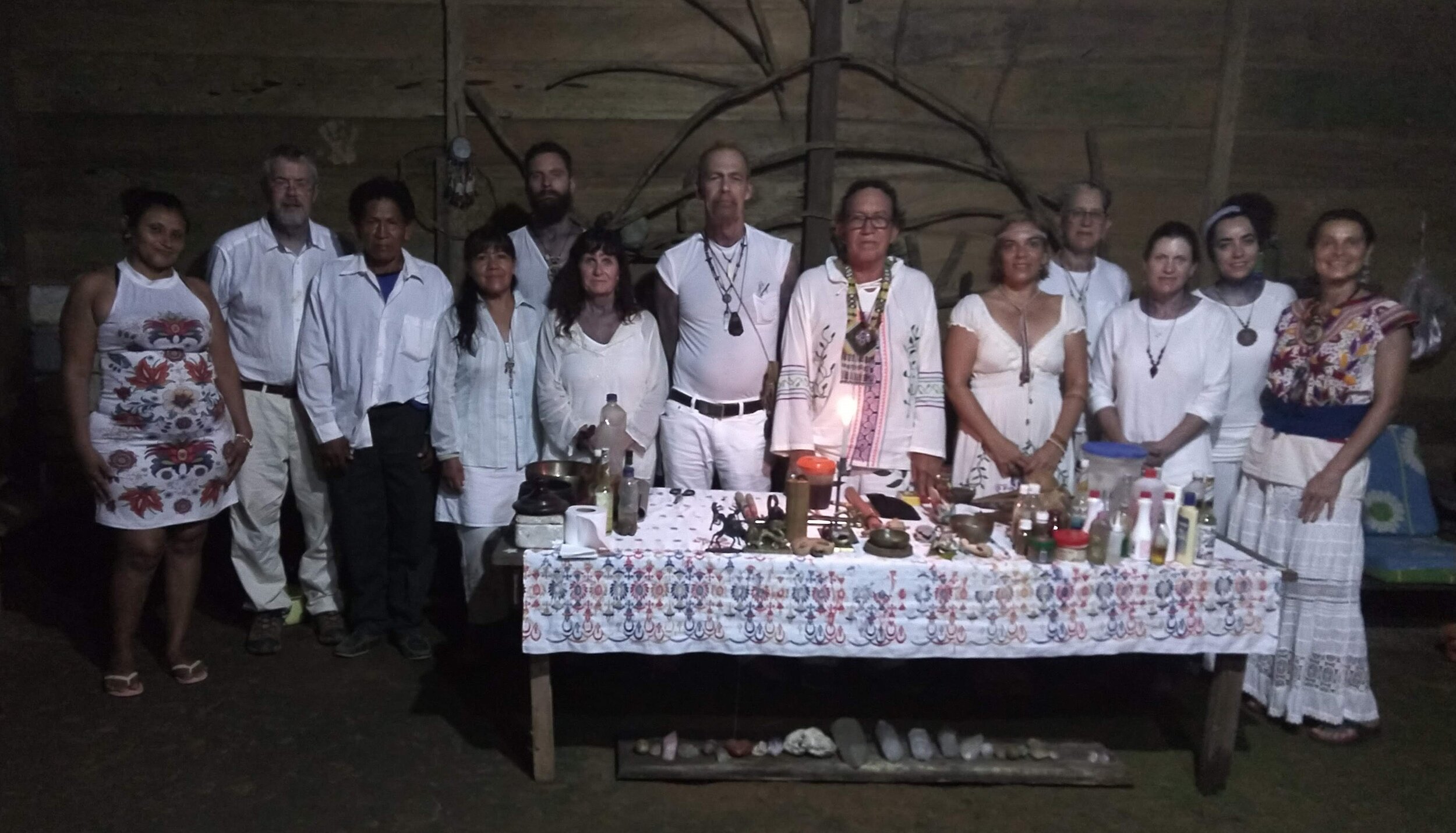
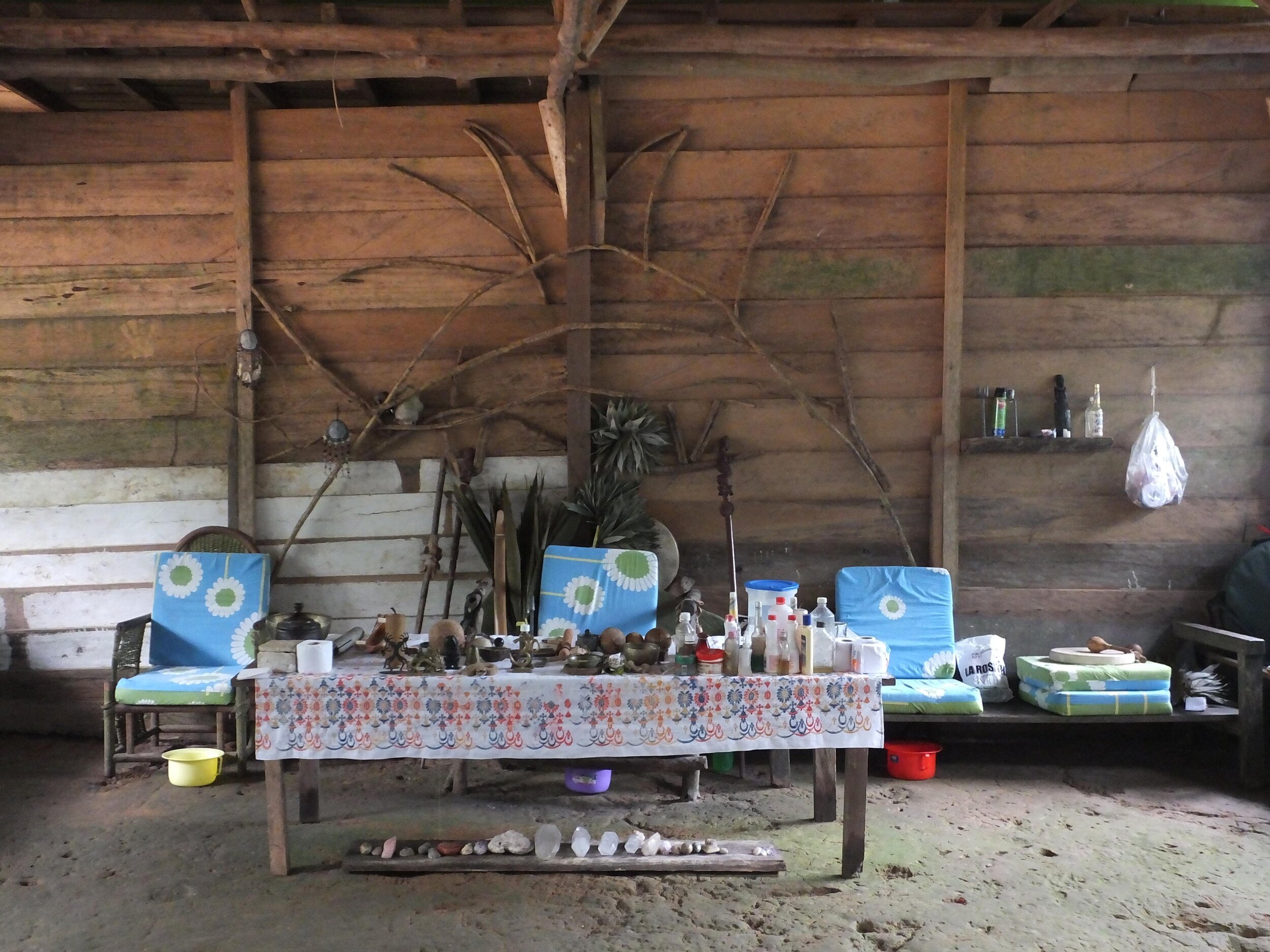
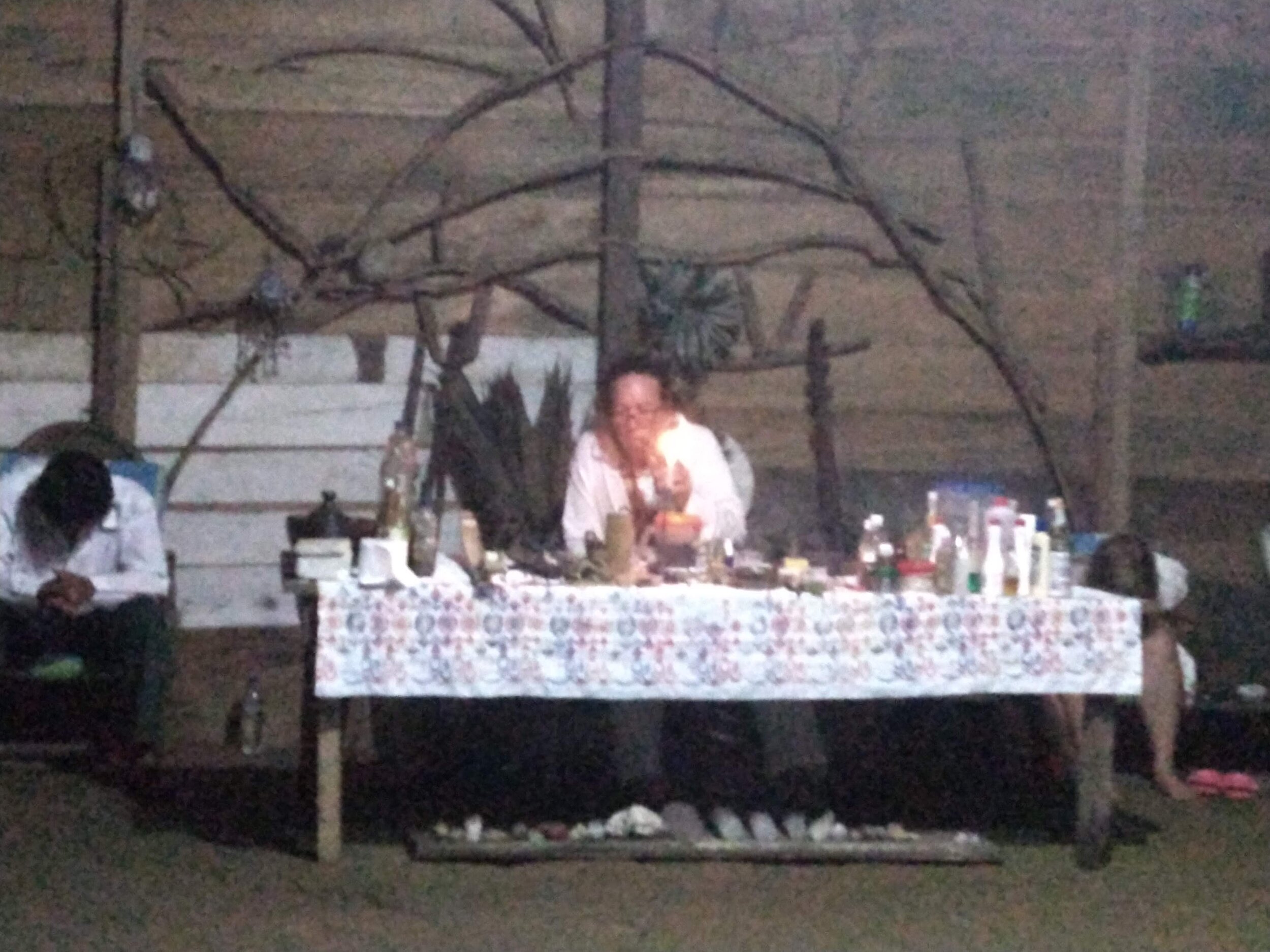
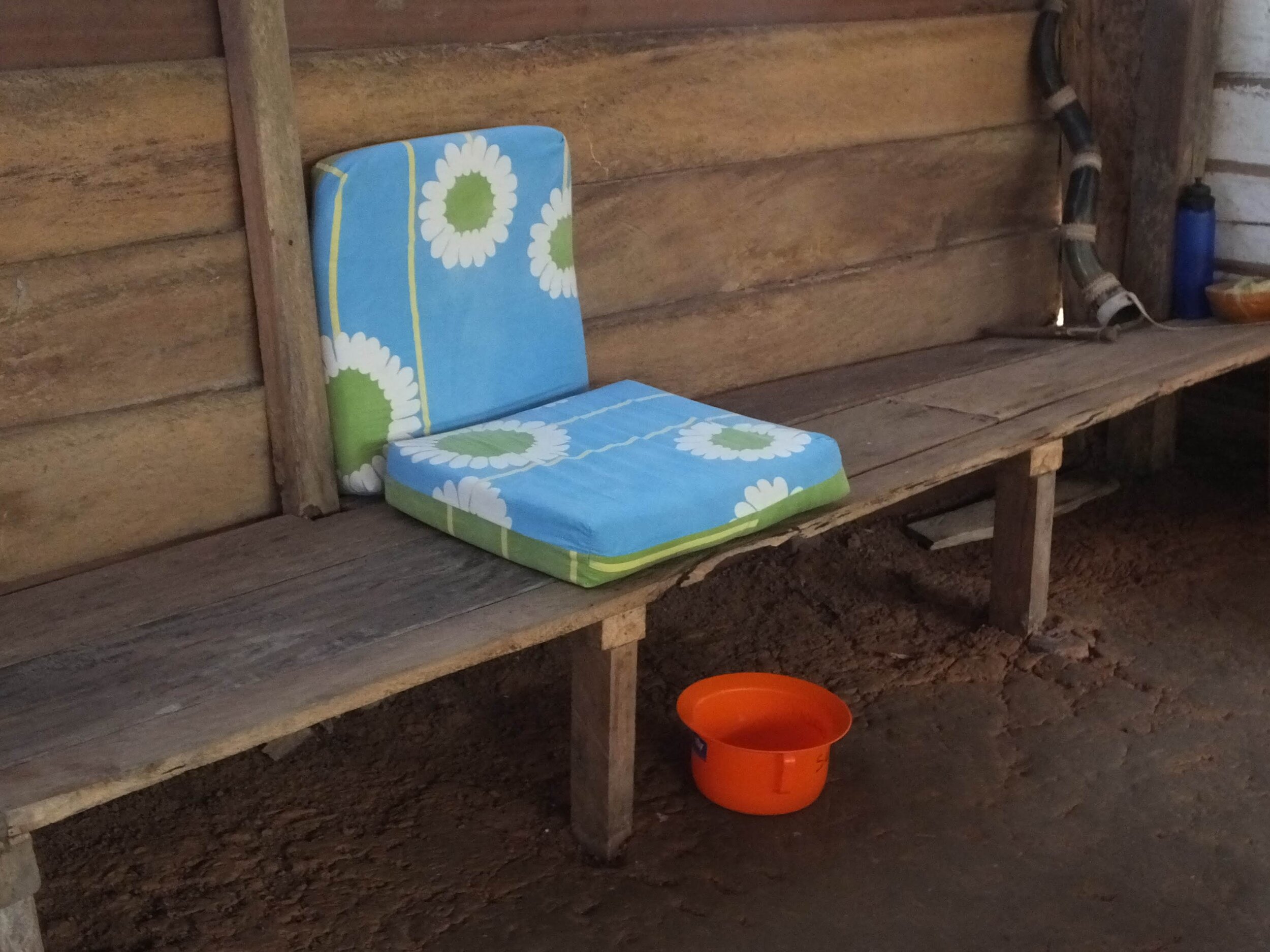
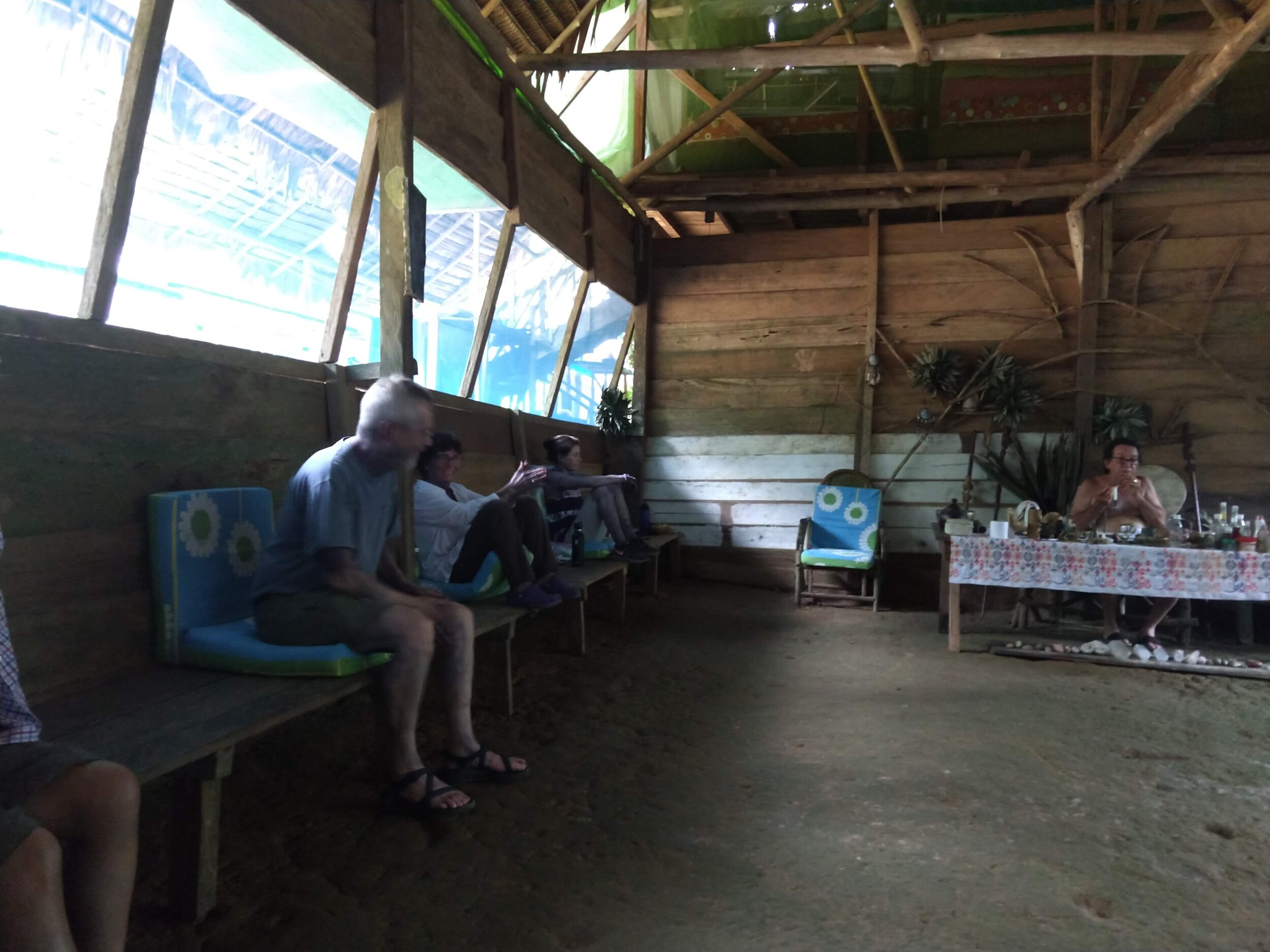
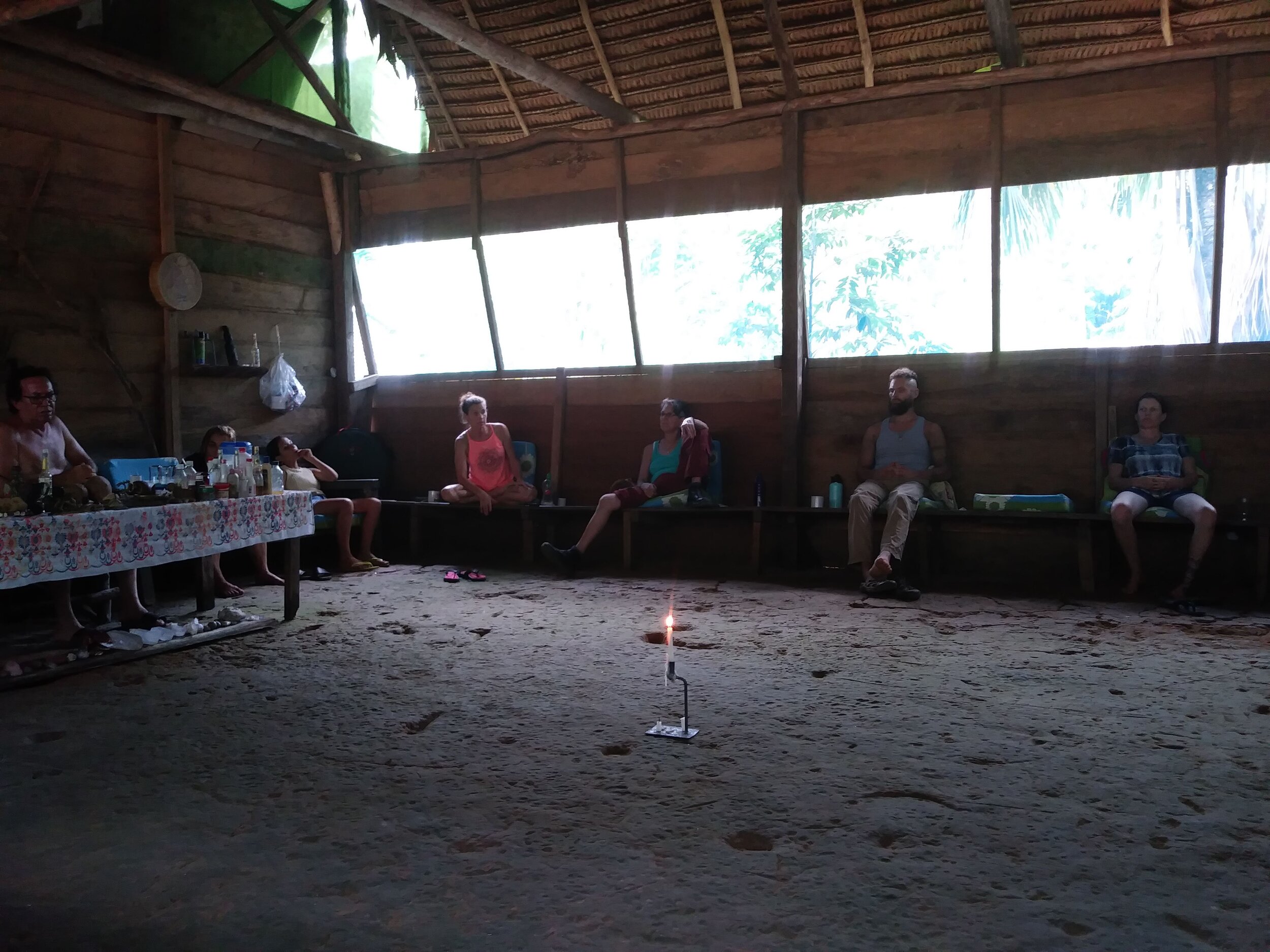
Viejo and Crow
Viejo and Crow have been close friends for many years. Though Crows name is a clear reference to his primary spirit animal, Viejos spirit animal is the dragon. The photo to the right was taken by Viejo as Crow smoked his dragon shaped pipe during a ceremony, and Viejo immediately saw the dragon shape emerge in the smoke.
Below is an original painting by Miriam, one of our translators, honoring this friendship and connection. It is done in the traditional Ayahuasca vision style.
Although Ayahuasca was the centerpiece of our medicine work, there were many other ceremonies and instruction that filled our days as well. Among them was a burial initiation, which is one of many shamanic rituals that focuses on death and rebirth. A number of shallow graves were dug by the staff ahead of time, oriented East to West. Viejo and I prepared the site for the ritual by drumming as people gathered for the ceremony.
Preparing the burial ground
Viejo and Crow prepare the site with drumming and prayers.
The burial, or Death and Resurrection Ceremony, is performed in different fashion by different shamans, but the intent is for the participant to symbolically pass from their current existence into a state of repose and contemplation and then be reborn into a new life. Once buried, The shaman sings blessing songs, then stops, leaving everyone in silence for the duration.
After a time the drumming and song was resumed and each of us was raised up from our graves by our assistants, then led to the edge of the forest, to meditate and collect ourselves.
When the ceremony was nearly concluded, one of our group interred some of his fathers ashes at the foot of a large tree while the rest of the group held space and looked on.
As there was the possibility of rain the next day, we decided to to take our hike to Waira Chakra a day early. So after lunch we set out to hike through the jungle to meet the great trees. Waira is Quechua for the word, or idea, of wind. Chakra means ‘place’, ‘the place of’ etc. Waira Chakra is the name given to a very rustic encampment that is near two sacred trees, Mama Caspi and Taita Caspi, or Mother and Father tree. We hired some motos from the village to get us as close as they could and then began the walk in. After a fairly vigorous hike and a cooling swim in the stream nearby, we gathered at the foot of Mama Caspi to pay our respects and leave our prayers.
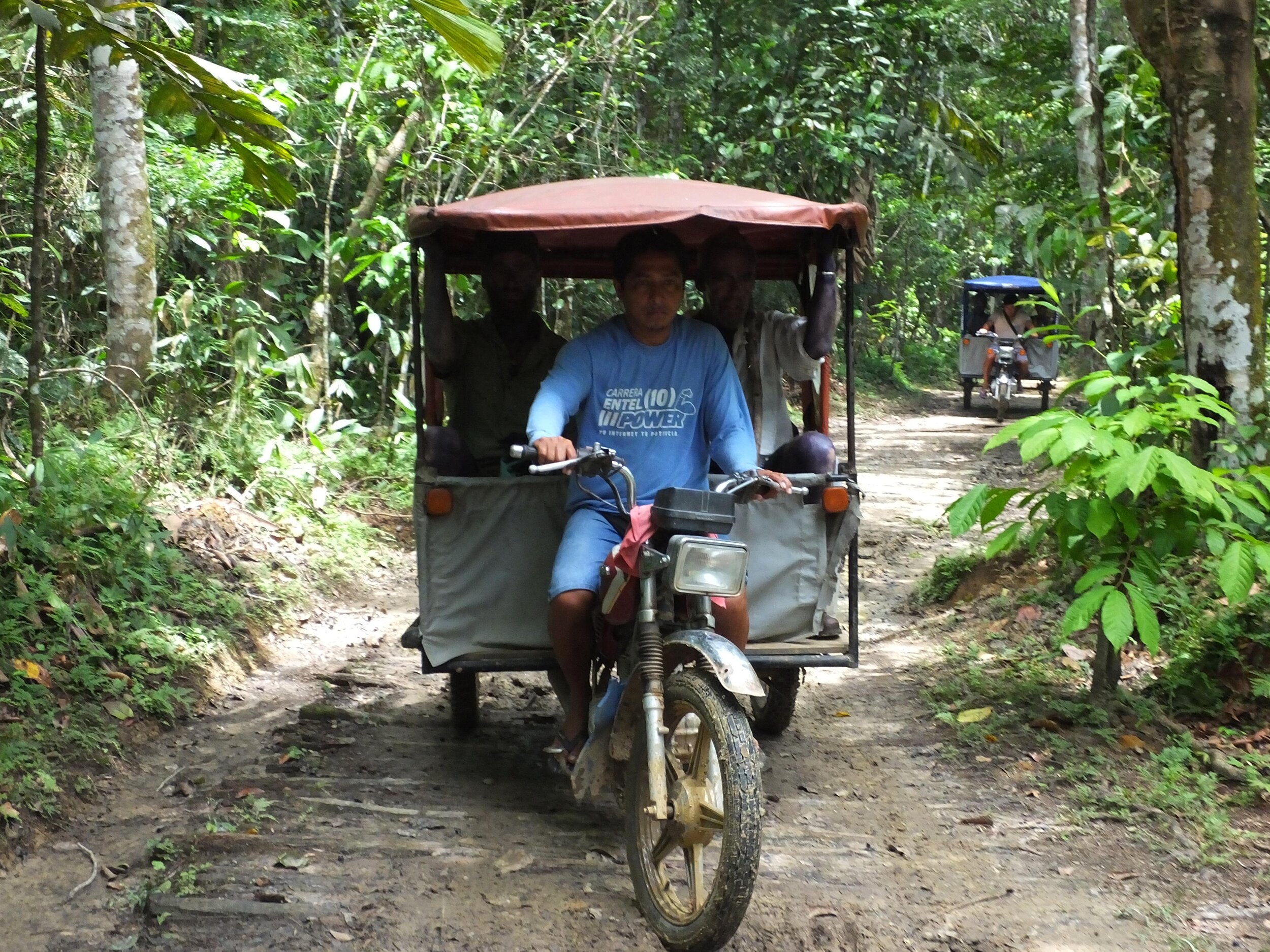
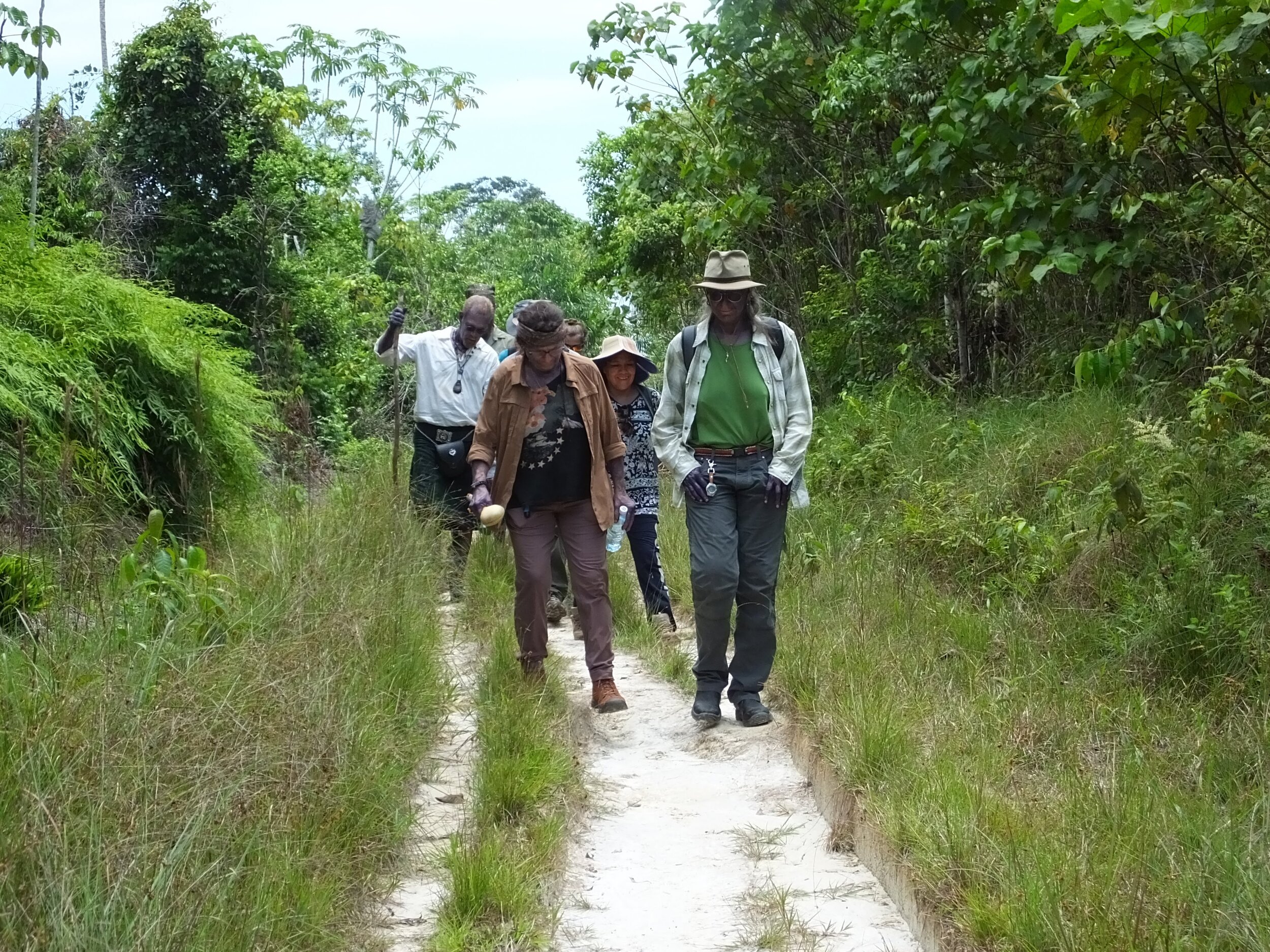

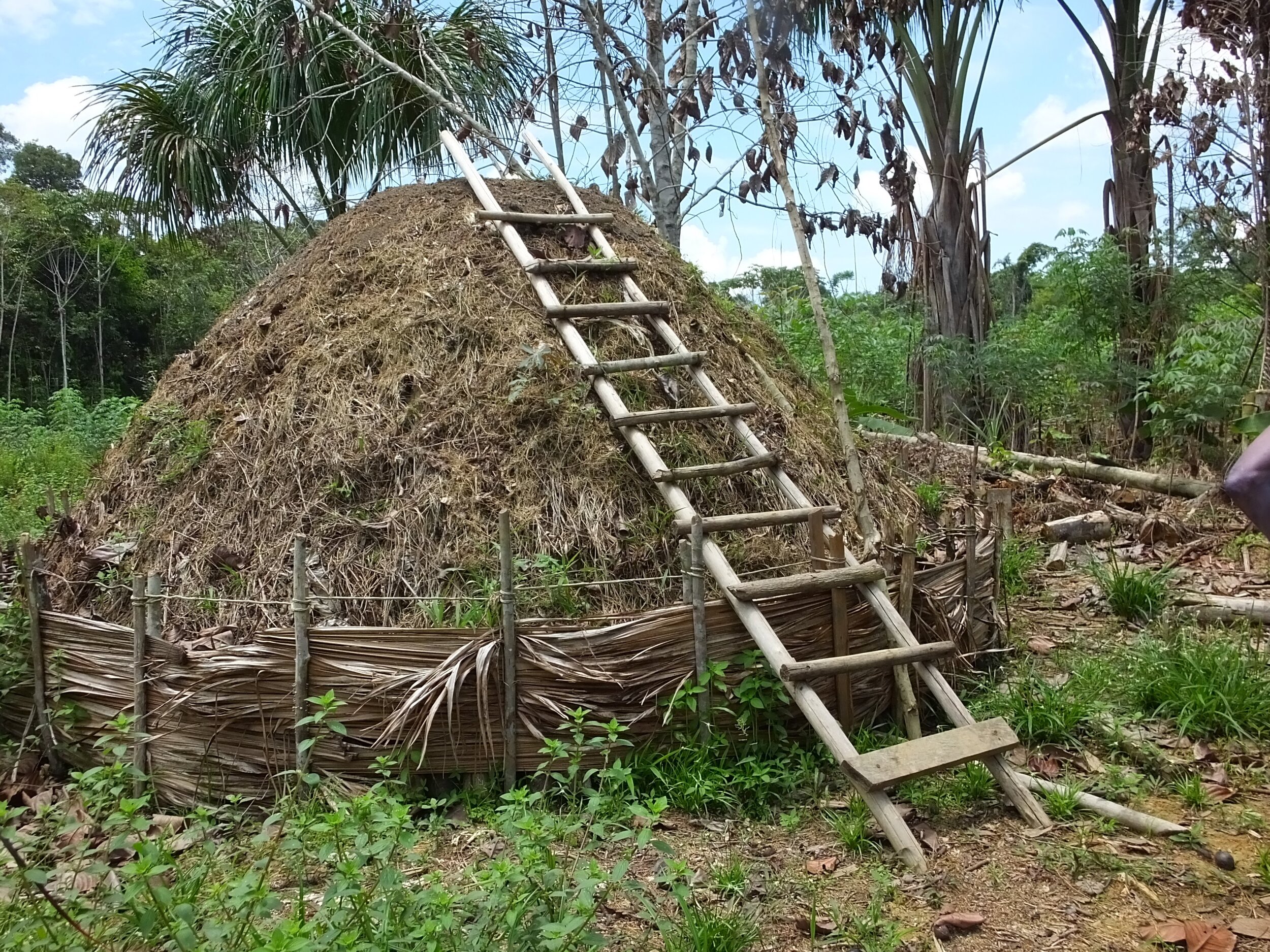
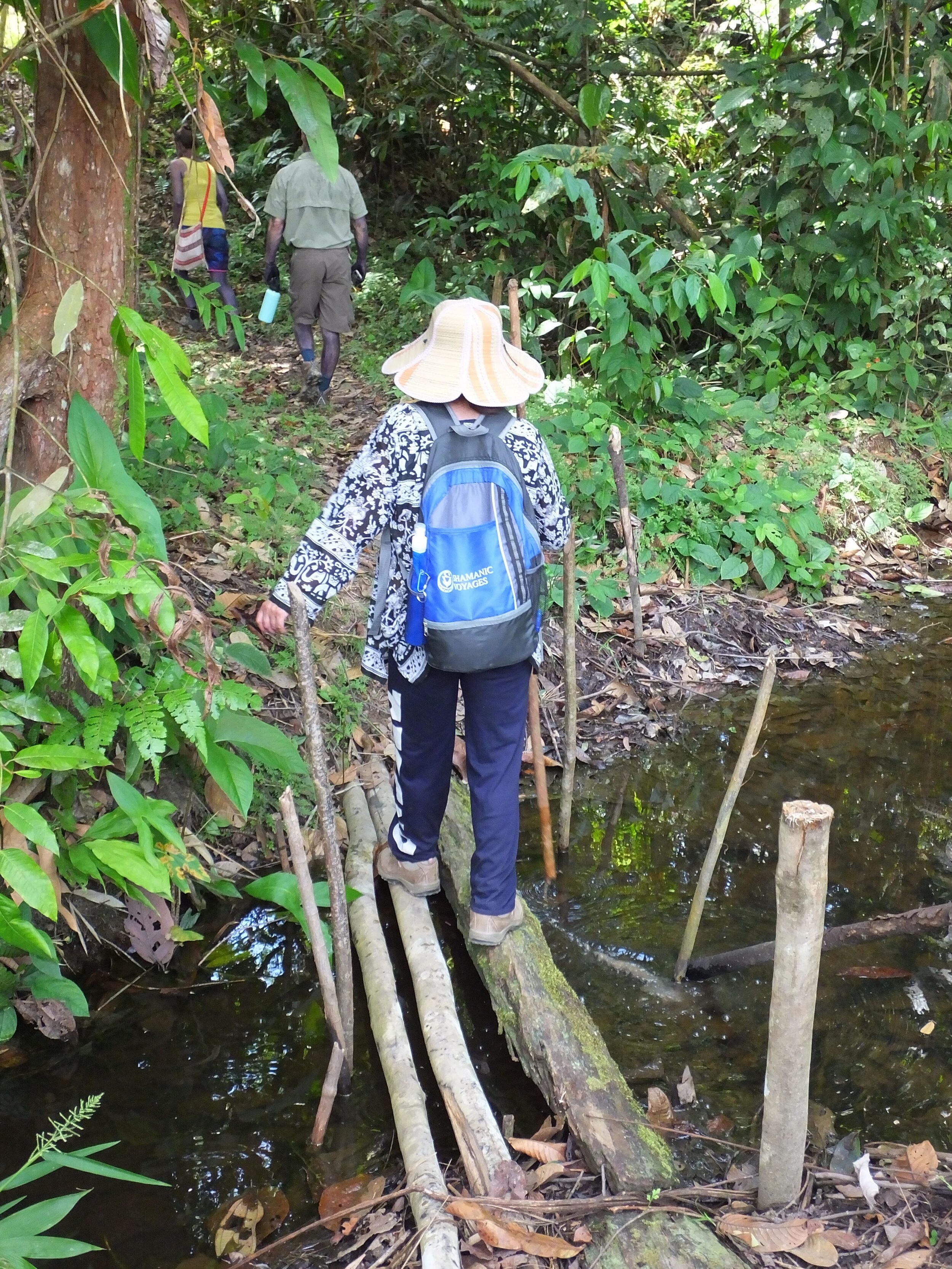
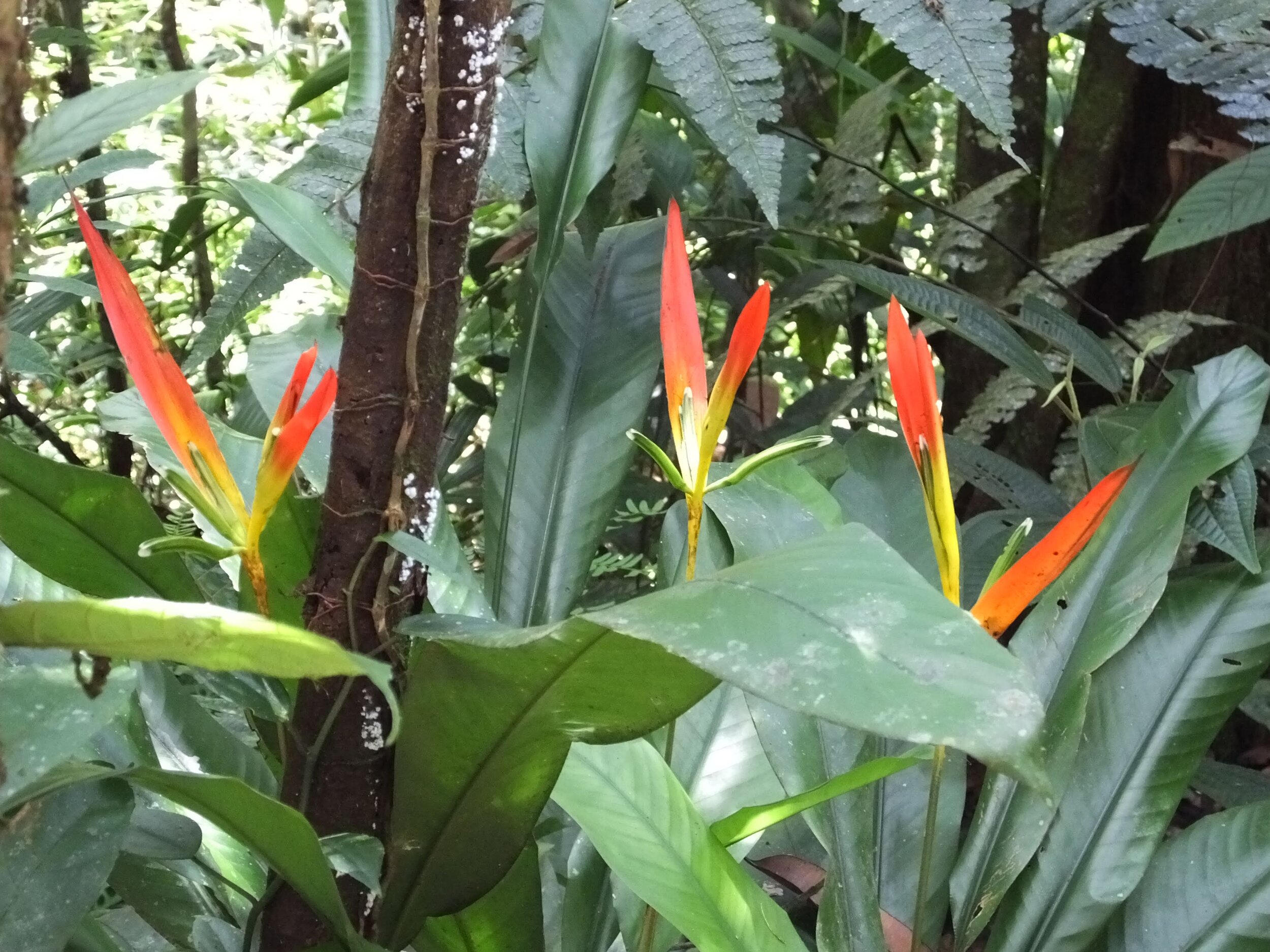

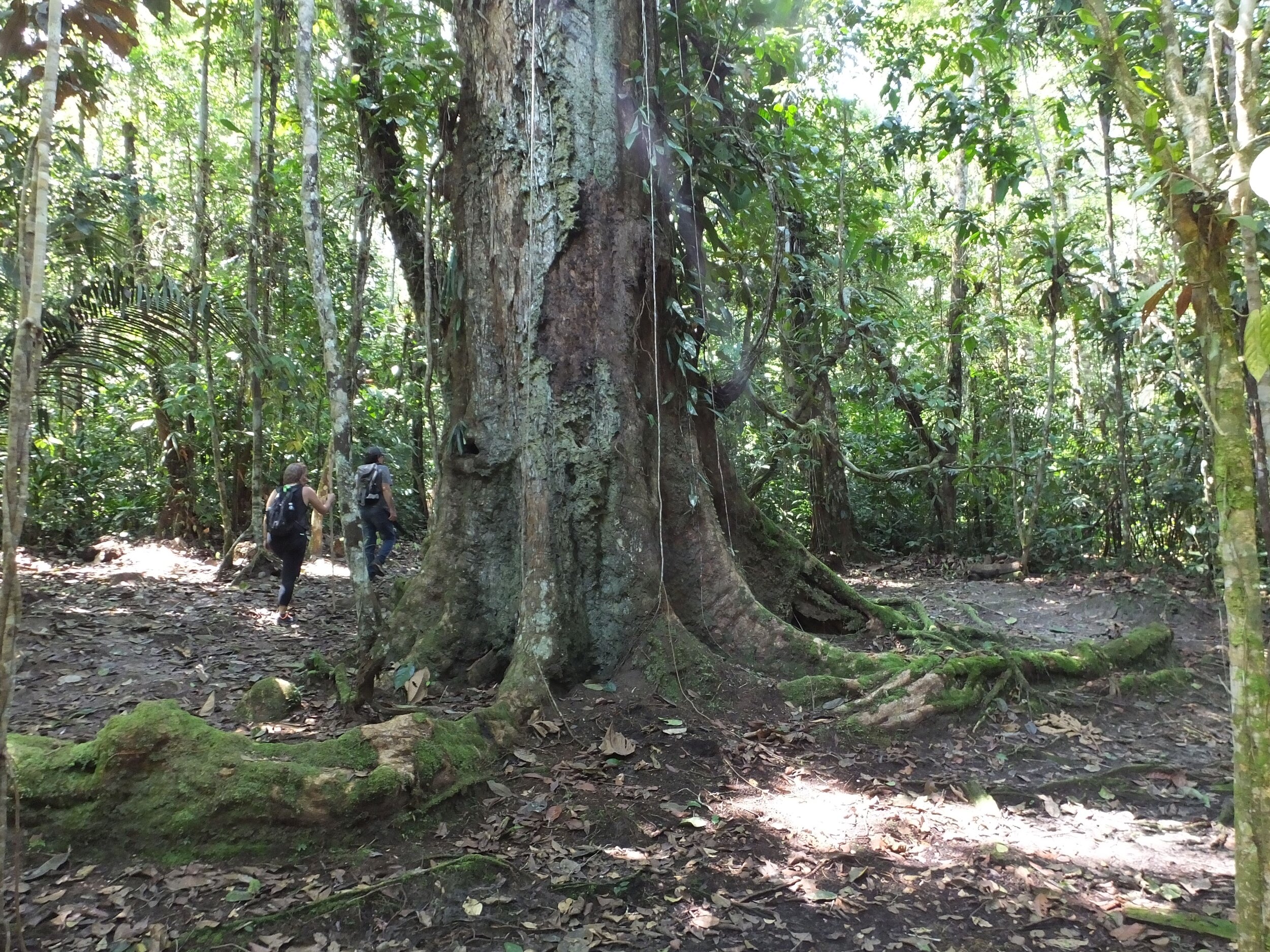

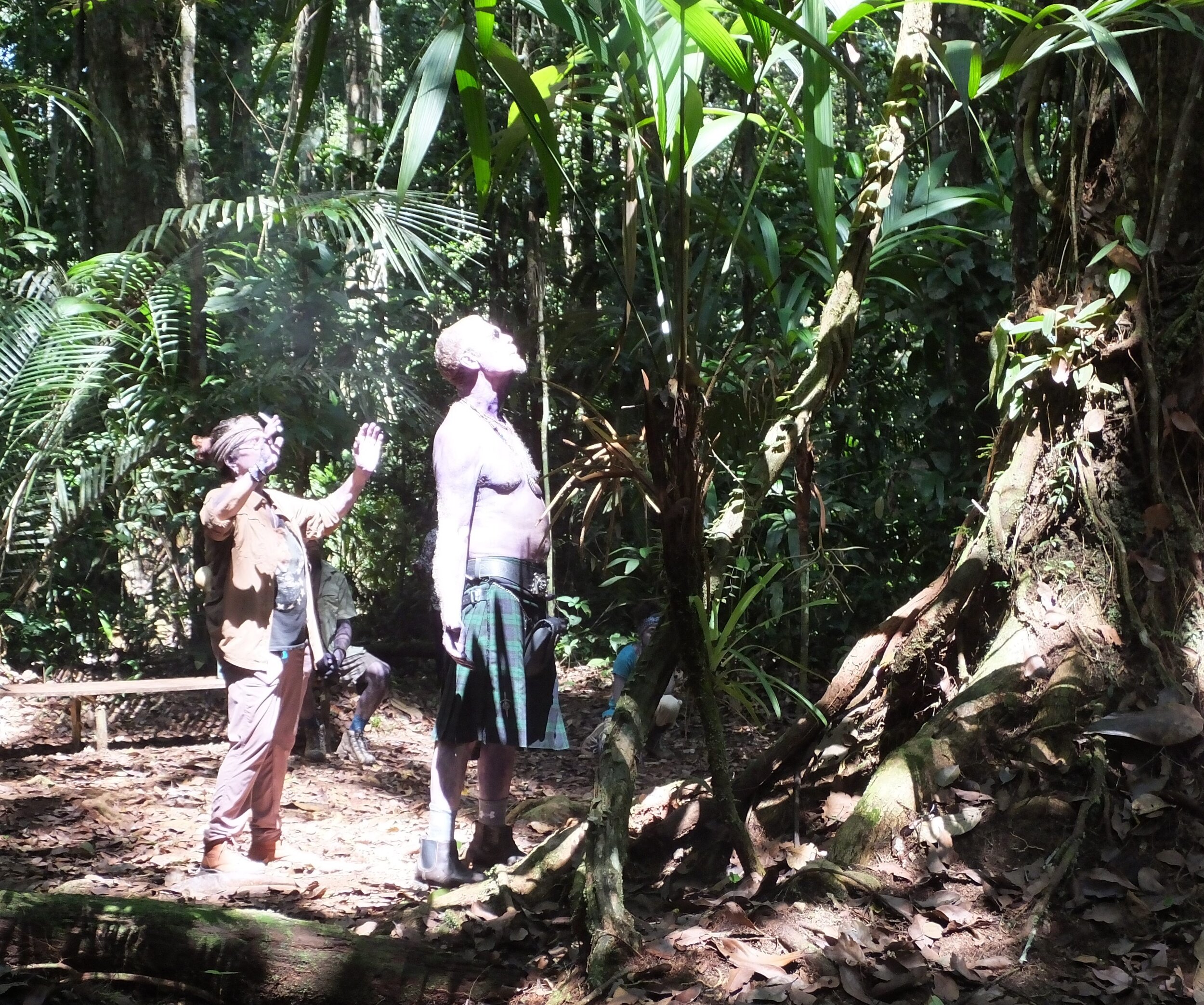
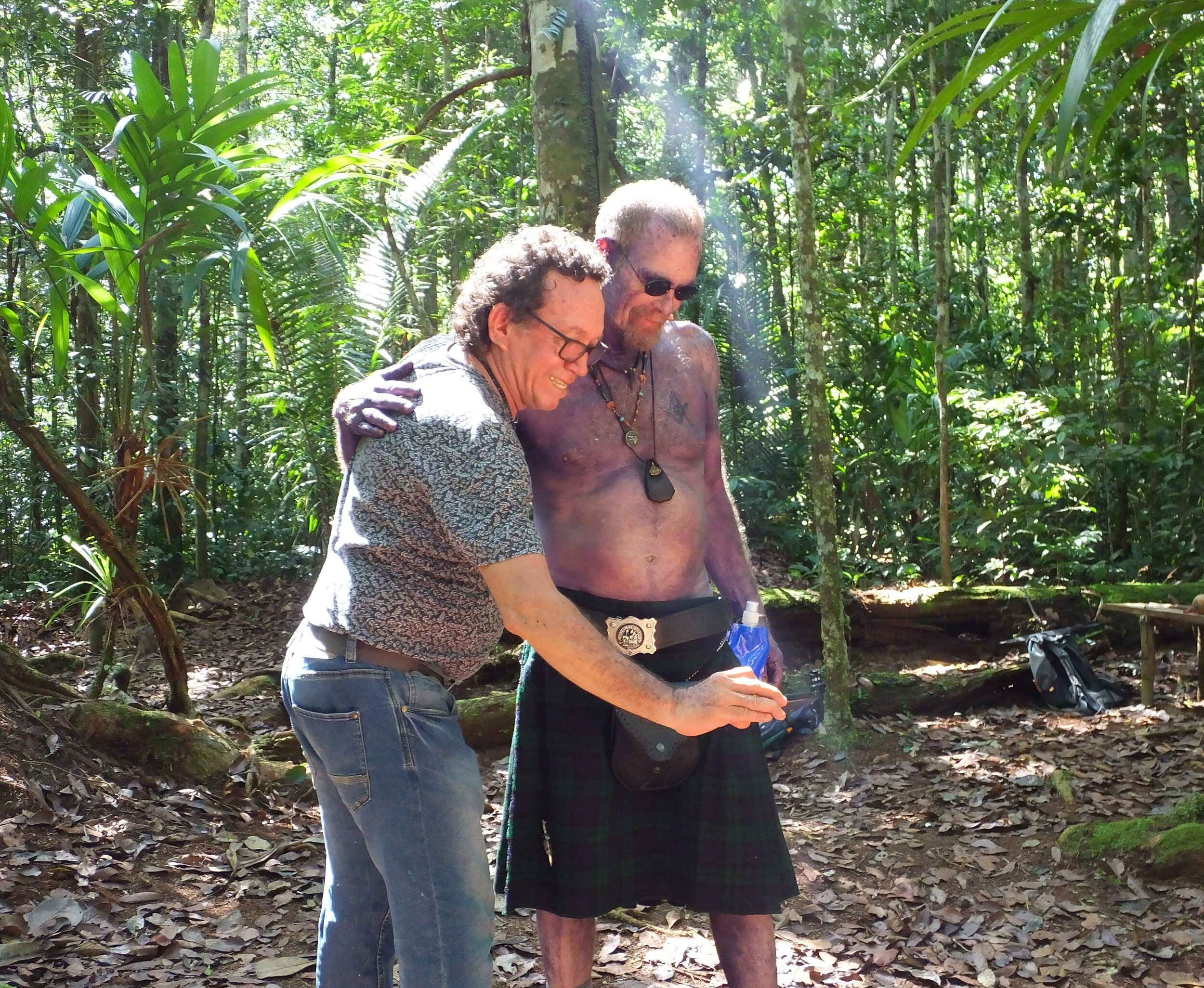
Among the many other activities that filled our days were plant identification walks, instruction of using breath and smoke in healing work, discussion and sharing the day after each Ayahuasca Ceremony, massage demonstration and instruction, working with other visionary medicines and one of everyones favorites, making the Ayahuasca brew.
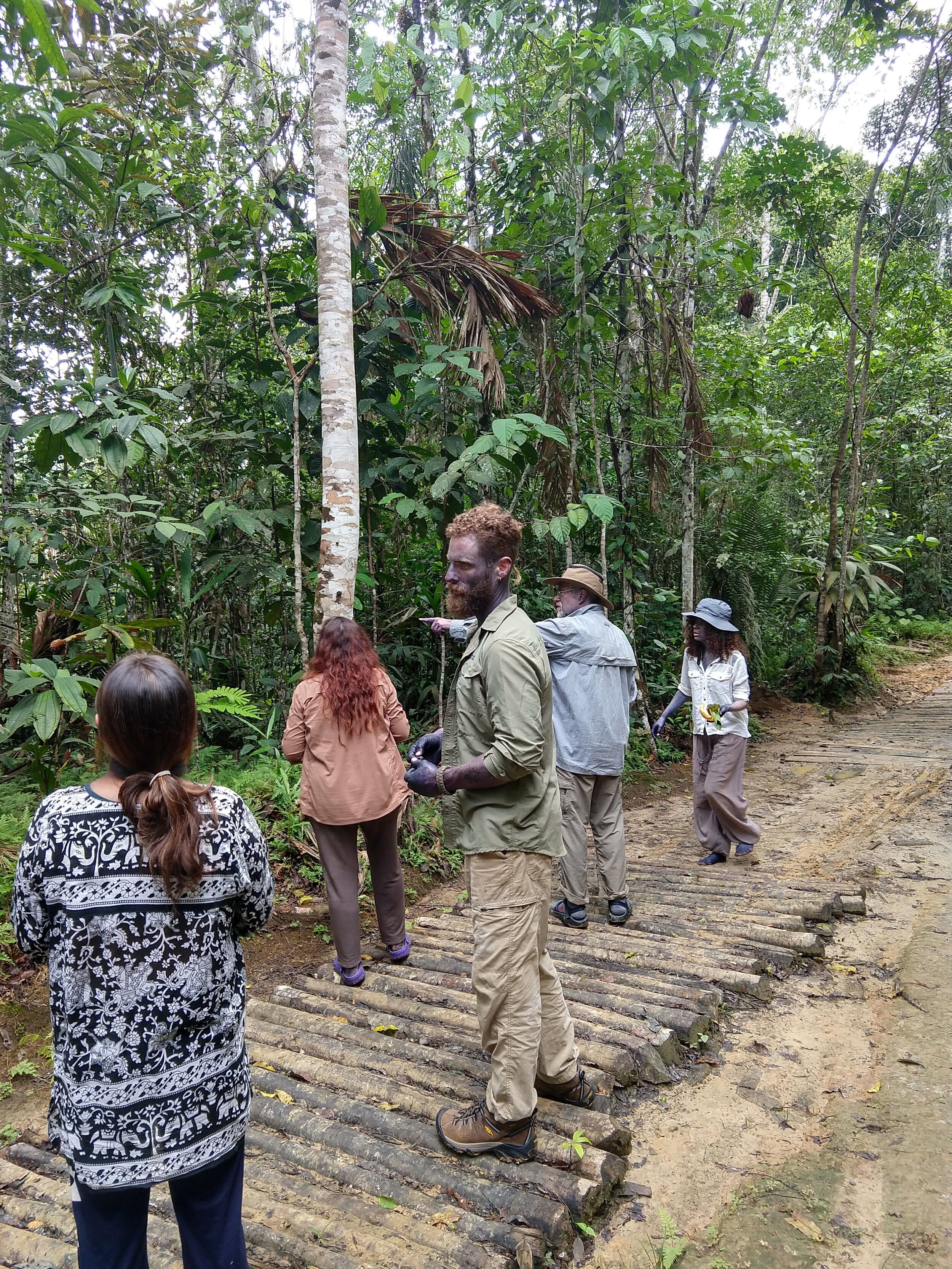

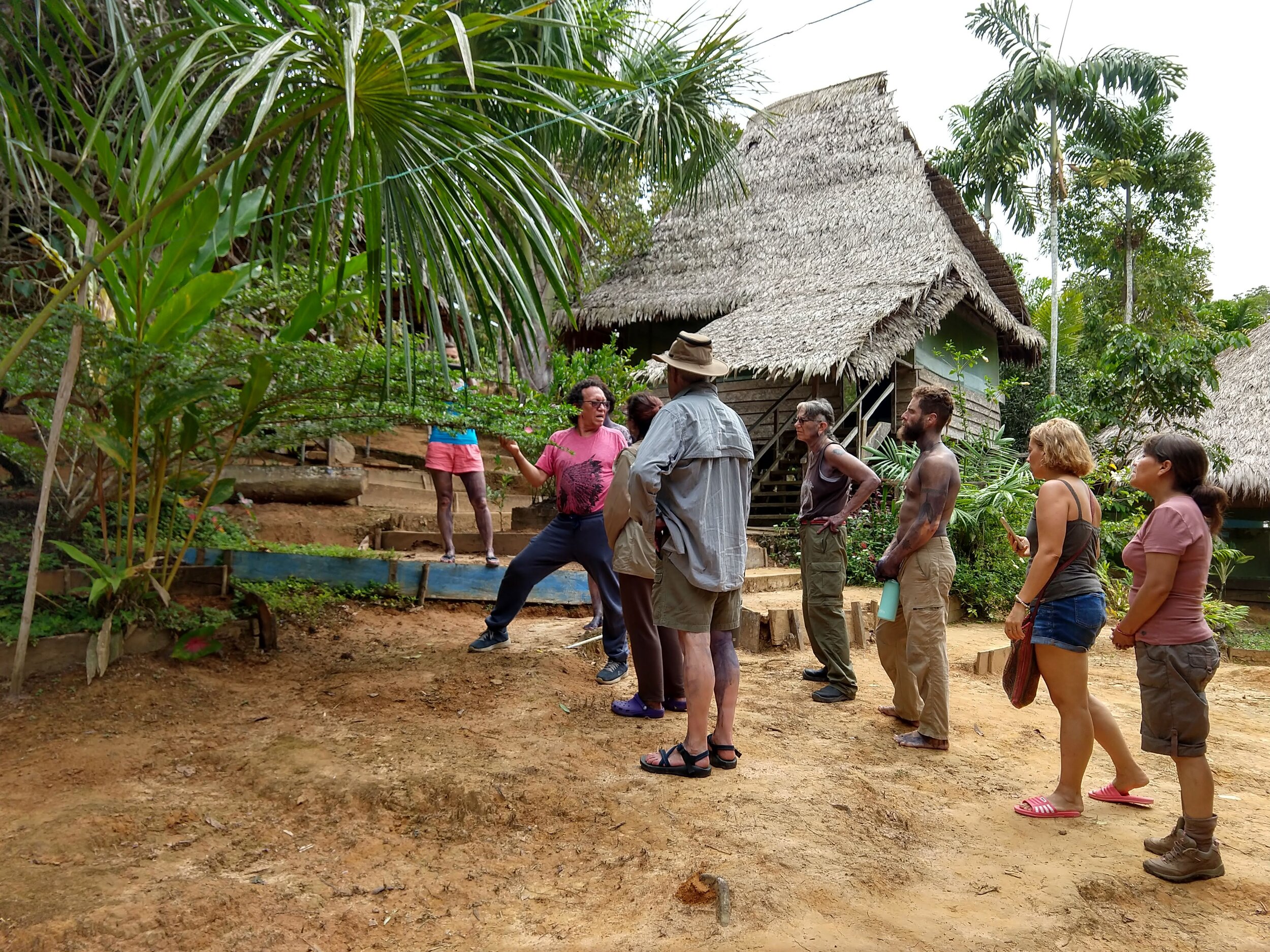
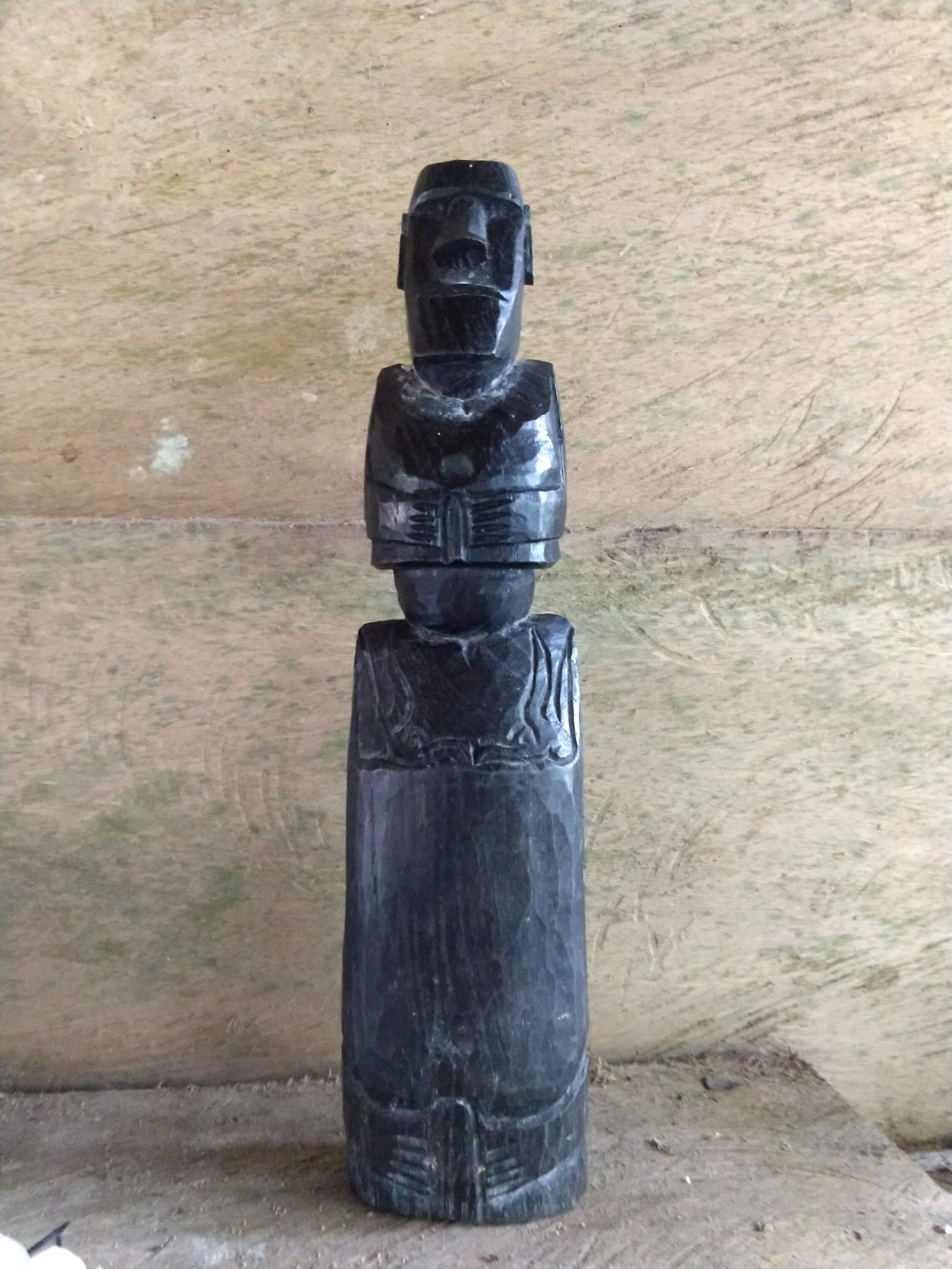
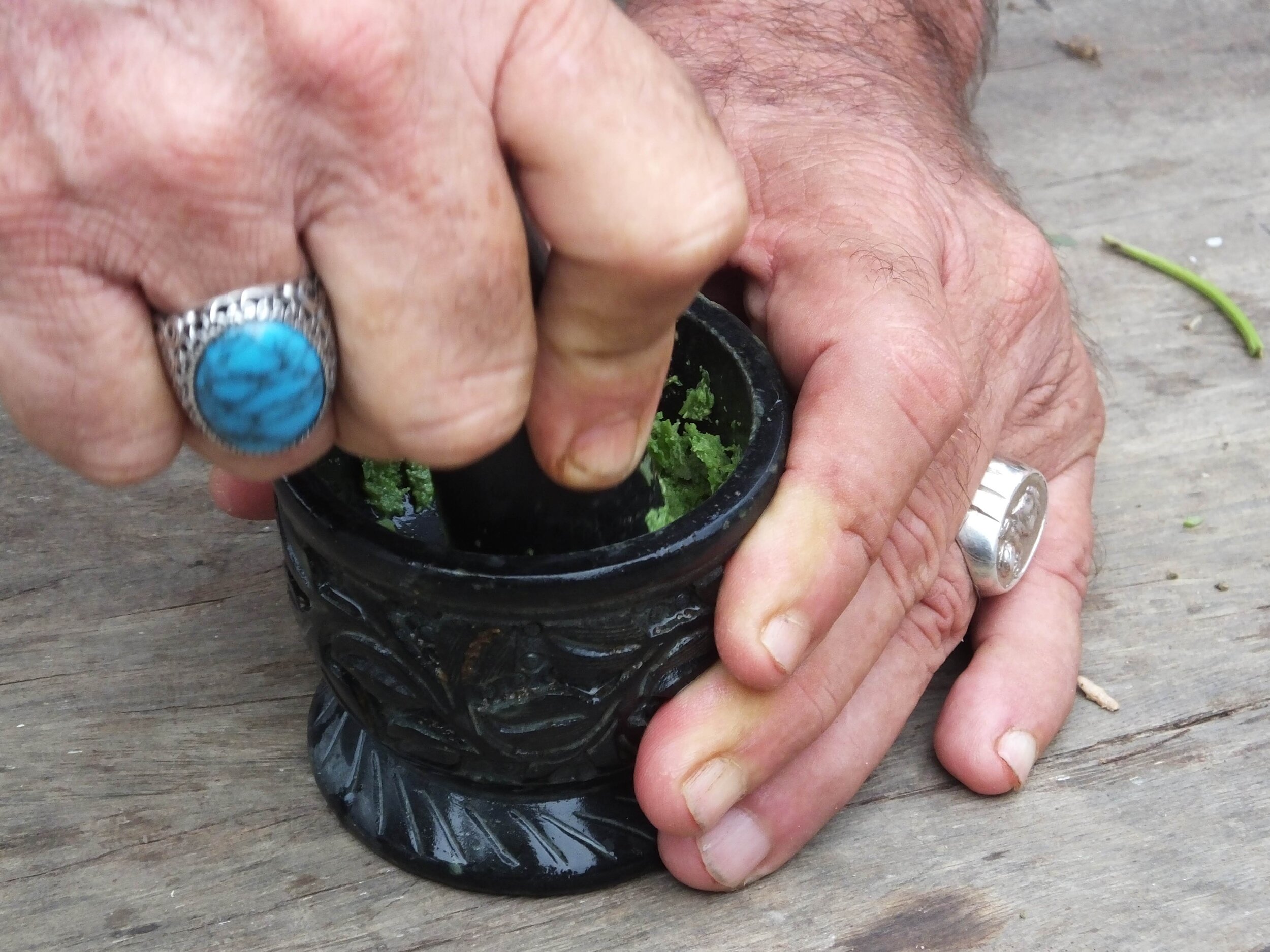

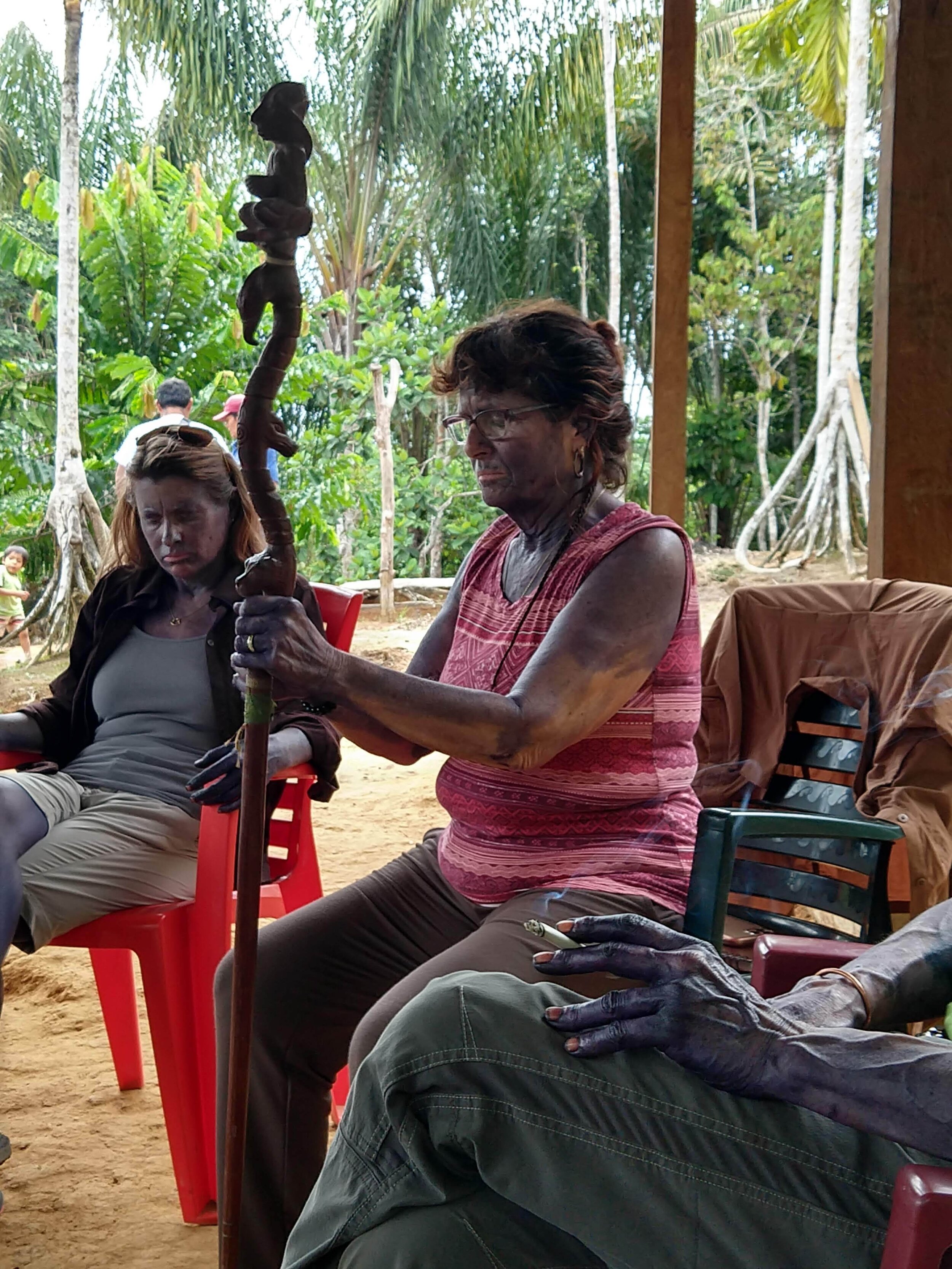

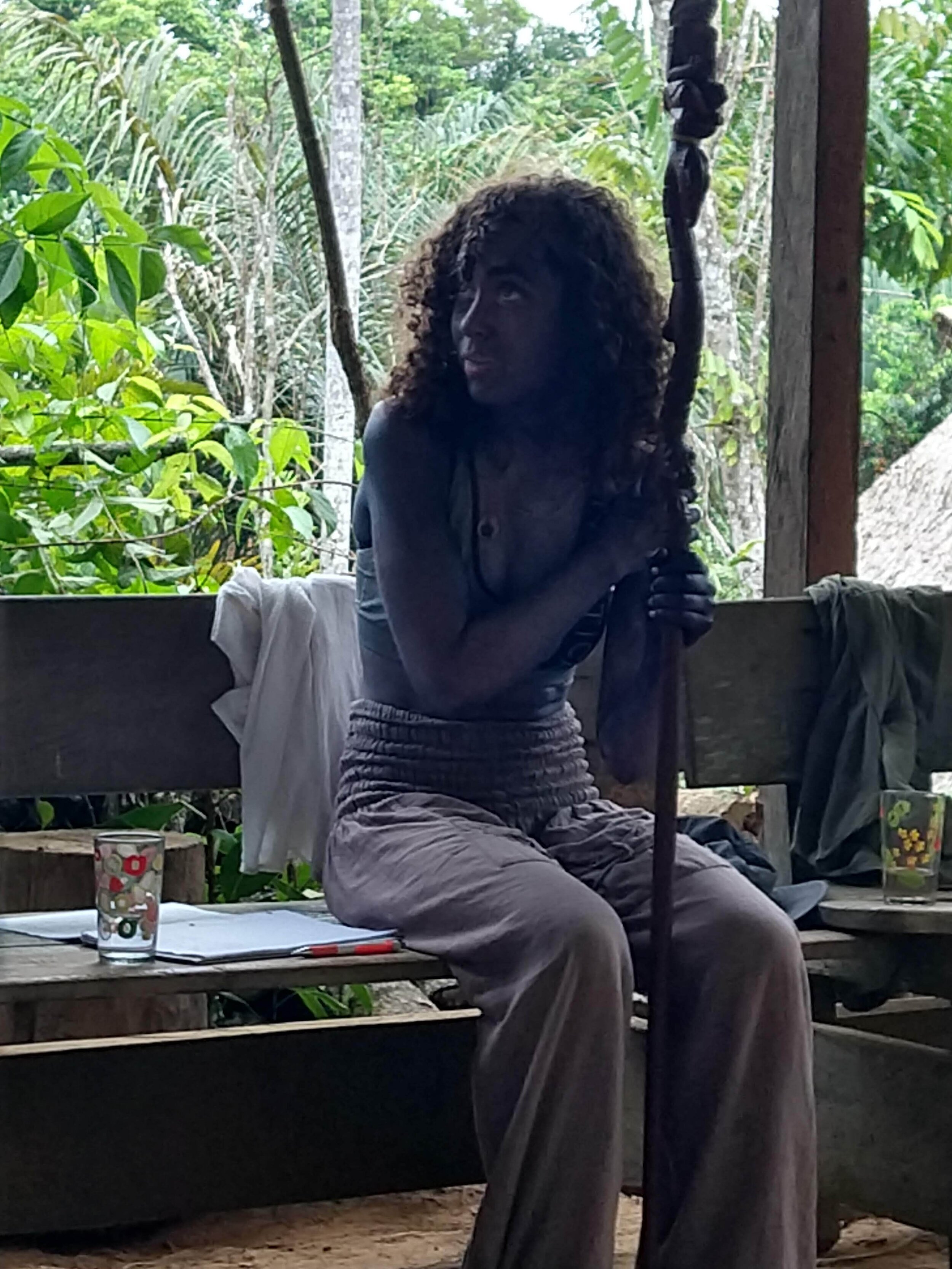
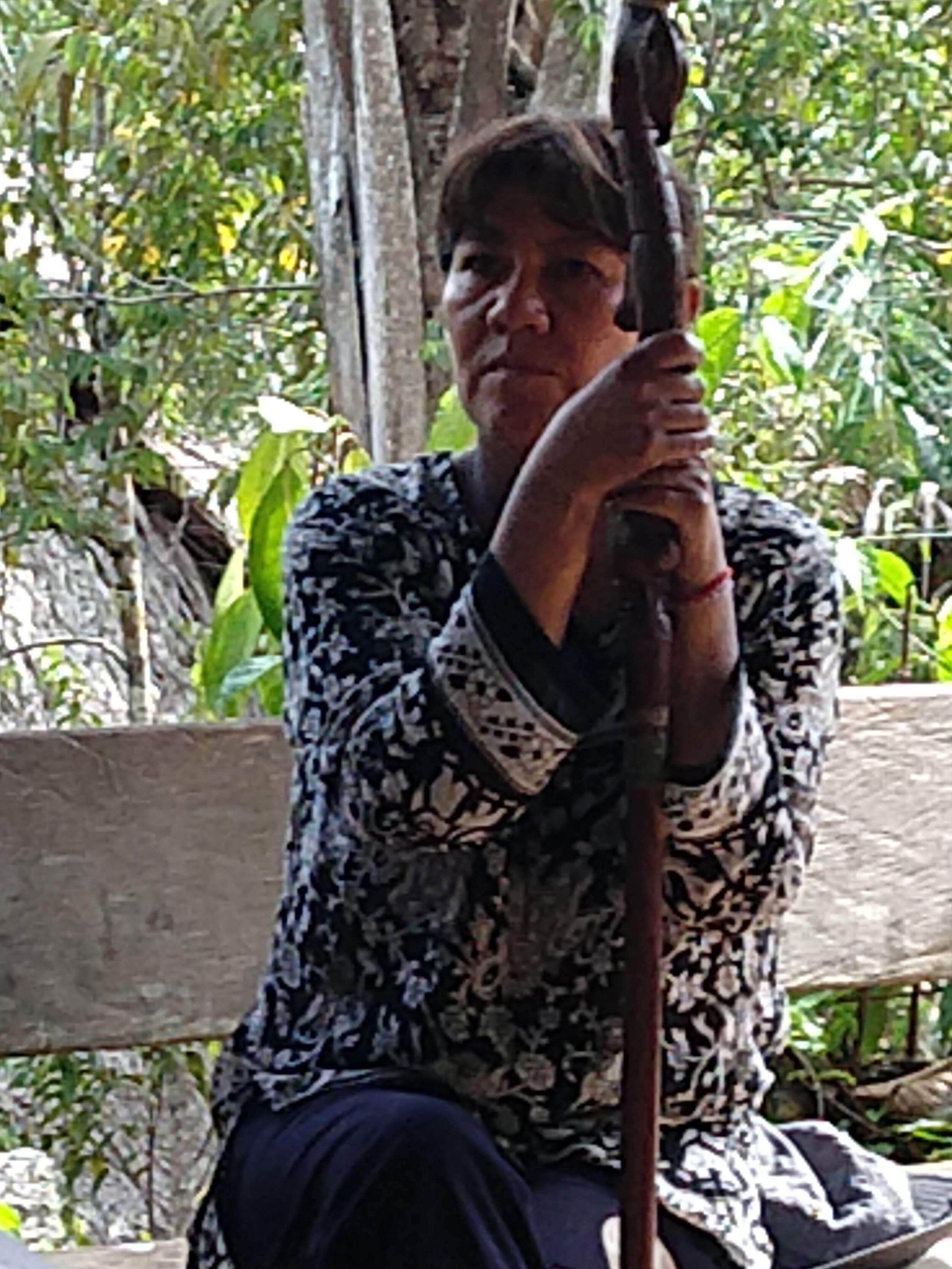
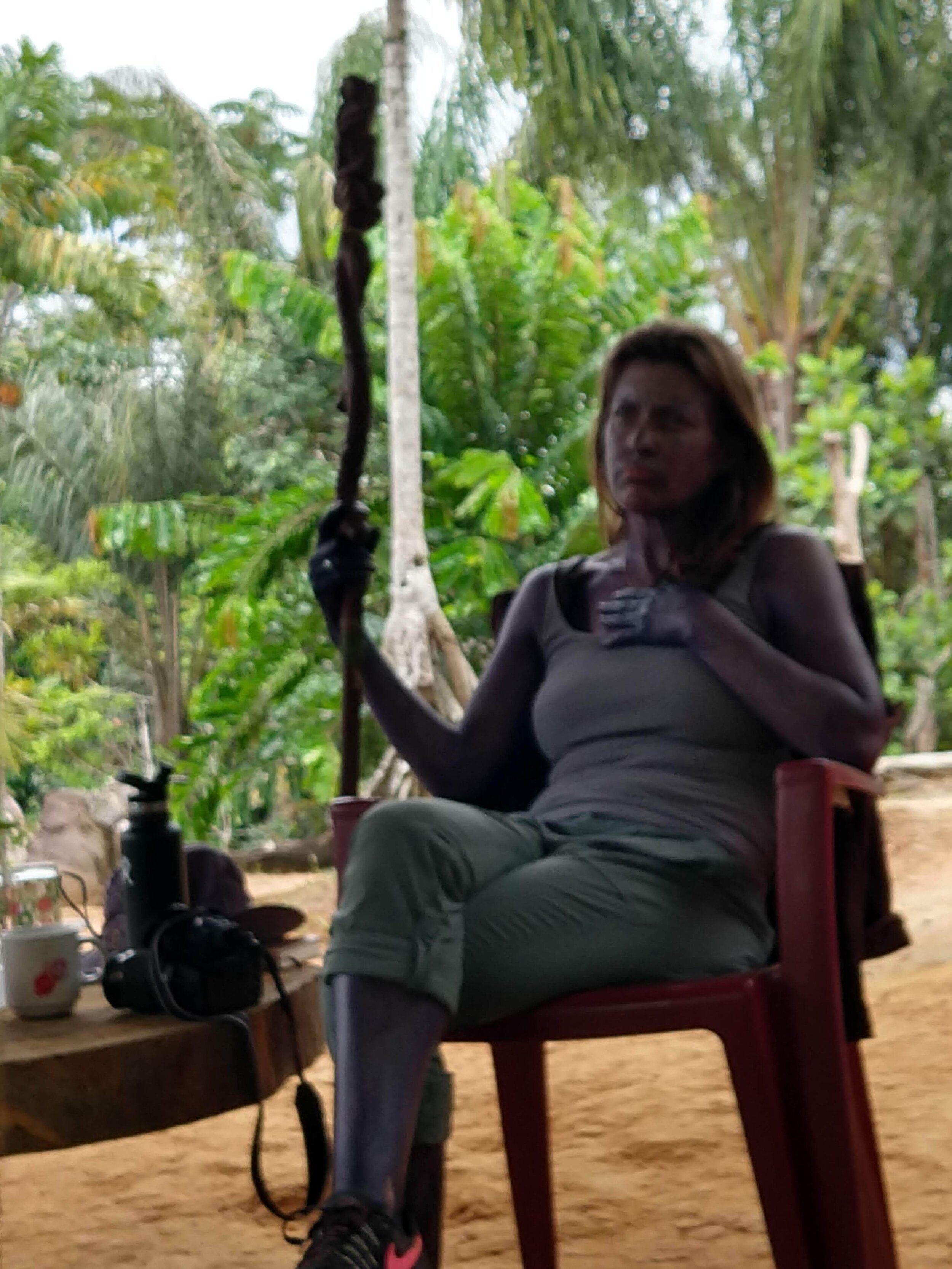
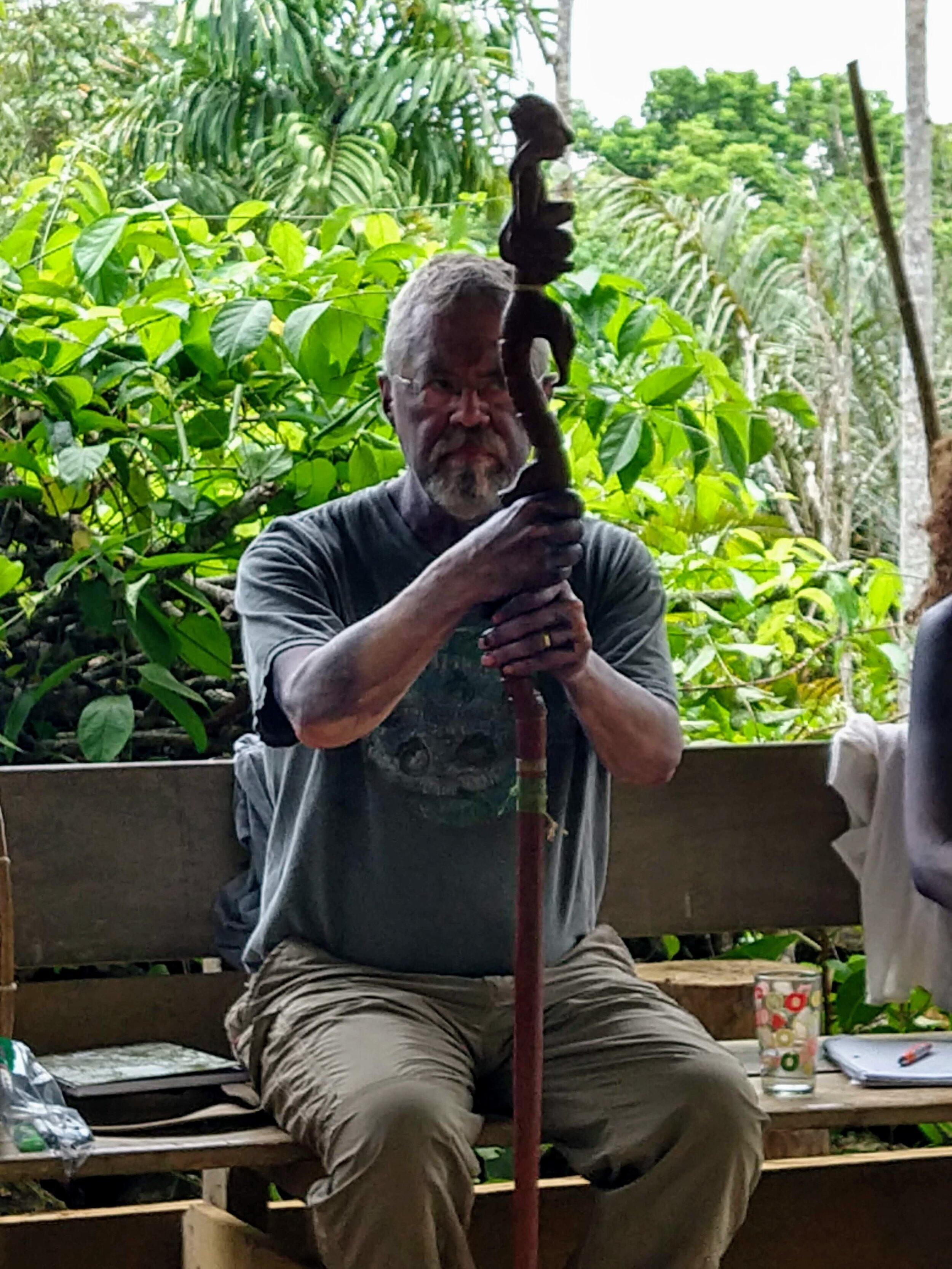
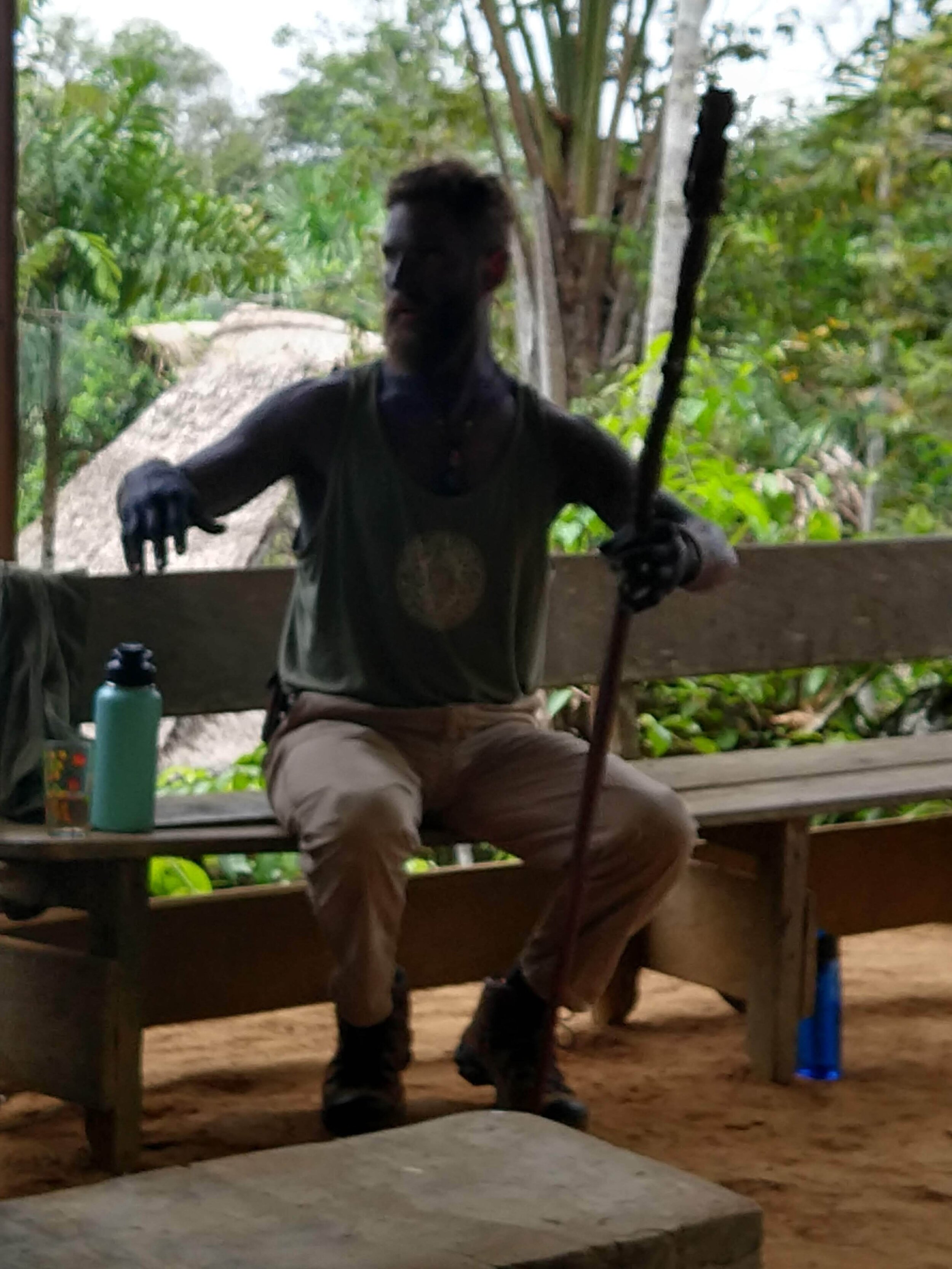

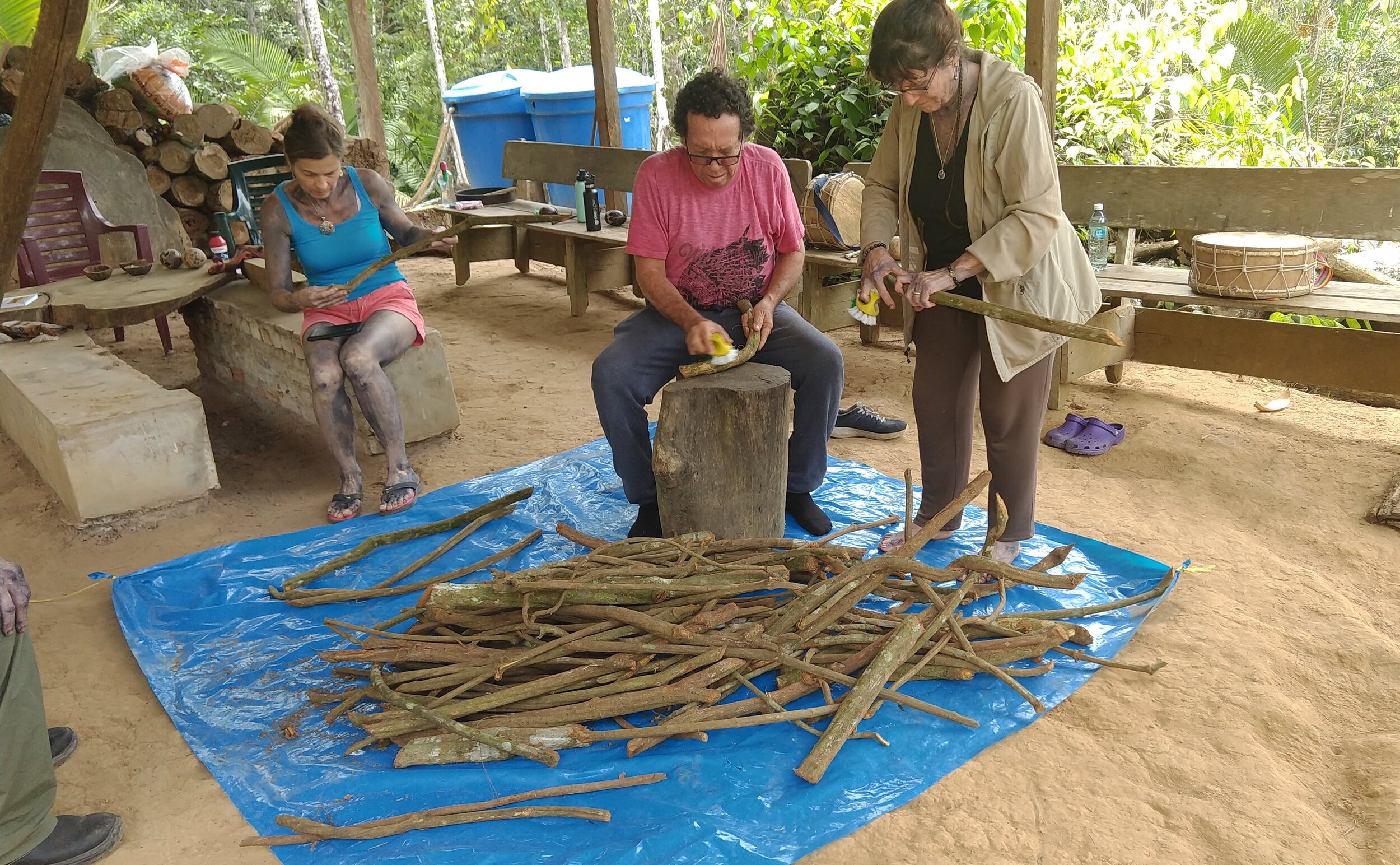


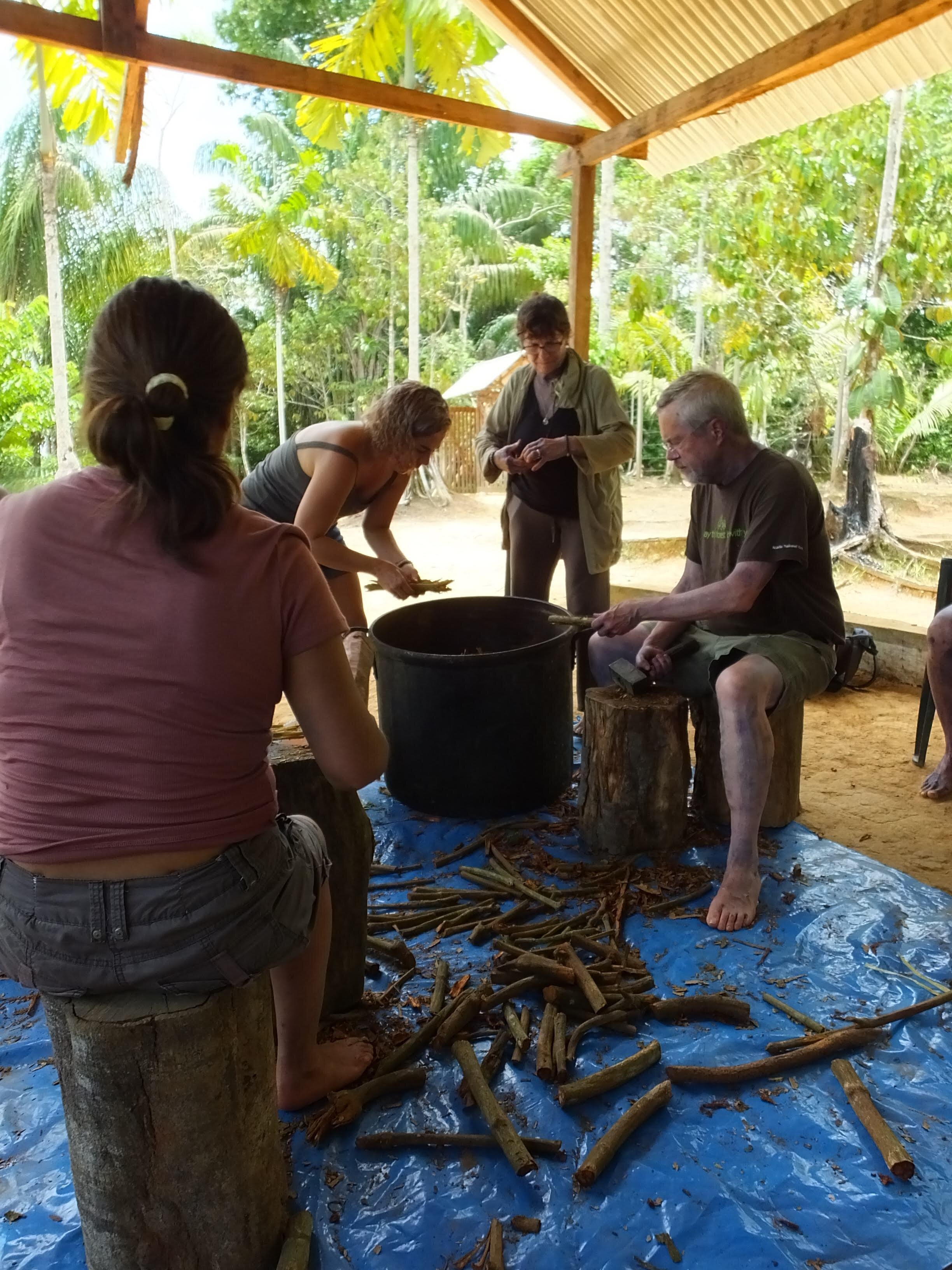

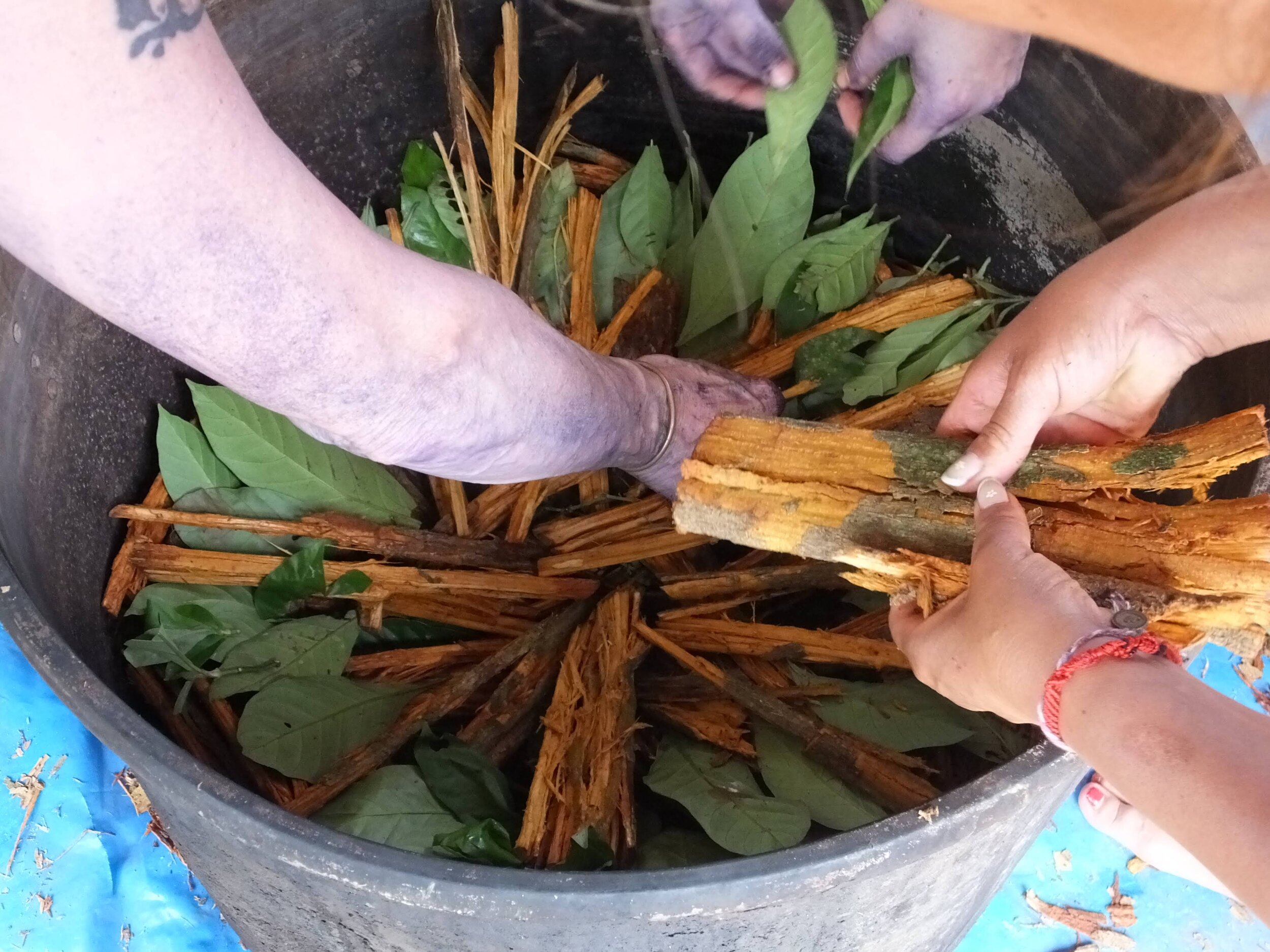
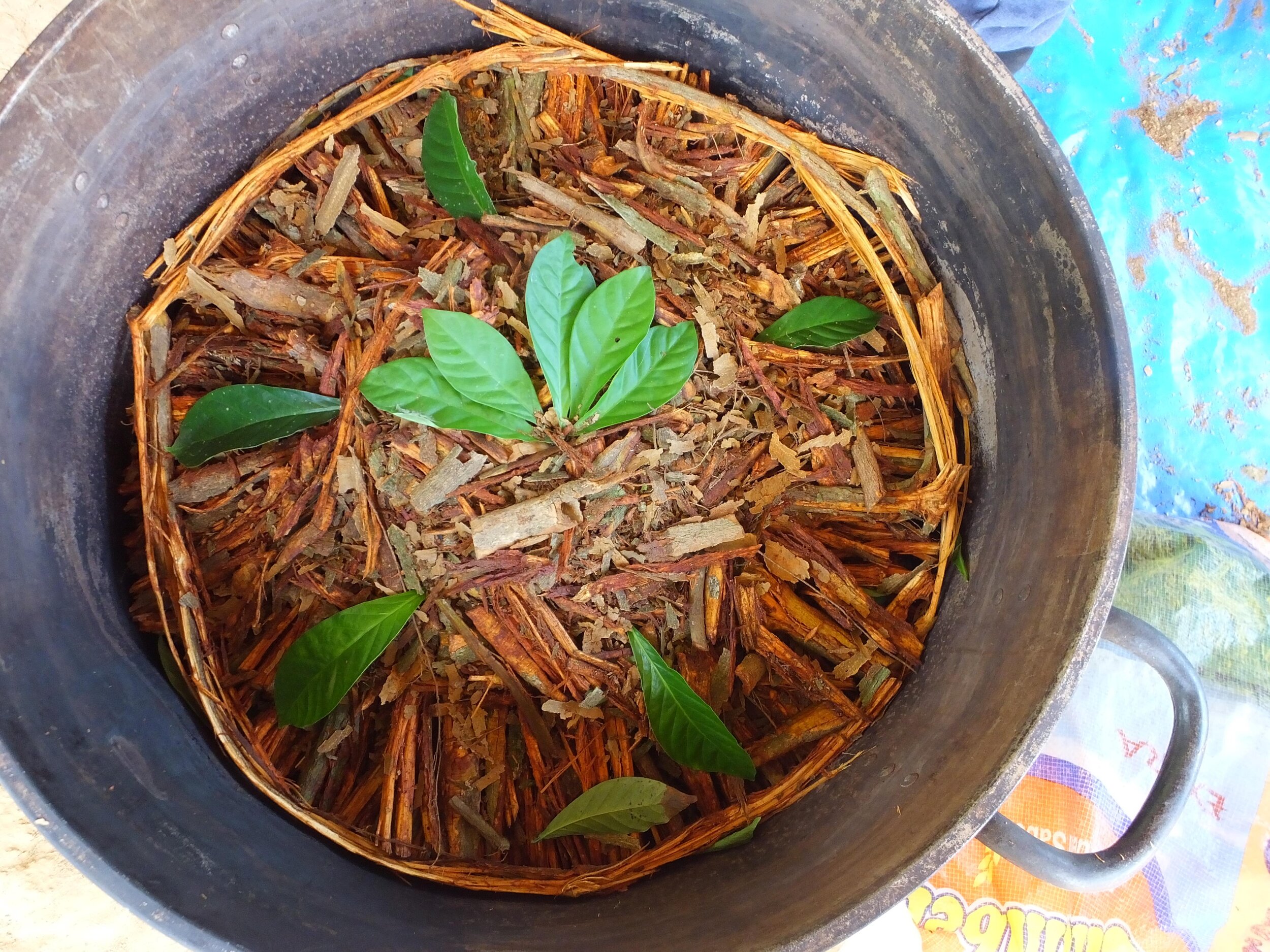

Viejos decoration on the drum I brought him as a gift
The outside world began to intrude upon our awareness in a big way on the 14th of March. The Peruvian Government issued a decree that shut down all air, sea, land and river traffic as of midnight that night. Due to the Covid-19 Corona Virus, a nation wide quarantine and strict curfews would be enforced. Opinion was divided on our best course of action. Do we leave now and try to get as far as we can, or sit tight and wait it out? I advocated for the latter course, much to the distress of many people back in the US.
So after much discussion, we agreed to not cut our trip short, but rather extend it till the decreed 15 day quarantine ran its course or another clear opportunity presented itself. We were in daily communication with the US State Department and officials from the government of Peru for updates.
Soon after the quarantine began, it was time to break our fast and begin to introduce a wider variety of foods. This was a good thing, as food from outside would soon be difficult to obtain. Because enforcement of the decree naturally would take a little while to become fully effective, we secured as much food from the village as we were able, and started to supplement our diets with fruit and fish from the immediate area. We also decided to limit ourselves to two meals a day to stretch out our supply.
The biggest challenge now would be to keep the group occupied and focused on the retreats work without undue worry about getting home. This was a challenge as rumors began to go around that things were going to get worse before they got better and that the quarantine would likely be extended, (which turned out to be true).
Now that excursions away from camp were prohibited, Viejo and I had to get creative with the schedule, as the itinerary had included more time in the jungle and visits to neighboring camps. Viejo decided to make some immune boosting drinks and have the group participate in their preparation, and we agreed to include a couple more Ayahuasca Ceremonies as well.
Many mornings we got to a late start, due to my efforts to stay in touch with the State Department and Peruvian officials, but under the circumstances, the group did a great job keeping a positive focus. We continued to work together, often to send healing and compassionate prayers to those suffering during this crisis.
As the days went by we celebrated two birthdays among our group, one planned and one unplanned. The first took place during our first week and this trip was part of a birthday gift to herself. The second was on our last night in the jungle, though we didn’t know it at the time.
The morning after our fifth Ayahuasca Ceremony, word came that the US State Department had arranged an evacuation flight from Iquitos the following day. With their help, and through many calls of our own to the Peruvian military, we were able to secure special permission to secure a boat from Tamshiyacu to the government marina in Iquitos, where we would be processed and issued travel papers.
We hastily packed our things, said our hurried goodbyes to our hosts and staff, then headed to the village to meet our boat.
The village was fairly quiet, at least more so than usual, with only a few children and several local dogs out and about. Most people were either in or just outside their houses as they watched us pass in our masks and bandanas, dragging our luggage behind. When we arrived at the dock, we were met by the National Police, who refused to let us pass. It was then that things became tense.
Our interpreters were told that nobody could leave today. We informed them of our safe conduct pass issued by a Colonel in Iquitos, which they claimed they had no knowledge of. It was then that we realized that two of the group were not police at all, but soldiers, and they stated that they were aware of the order, but the police wouldn’t budge from their position. There were about six police officers there most of the time, but some kept riding off on motorcycles only to return a few minutes later.
As Miriam argued with the police Lieutenant, who was insisting that we would have to wait until the next day to leave, (which would be after our flight departed), I called the State Department on my cellphone to see if they could help. They were at a loss, so I asked Miriam, (in my best poker face), to tell the officer that I had the US State Department on the phone, and they wanted me to take names and ranks of the police officers who were detaining us, to pass along to their superiors. They did not comply, instead we were told to wait. After a few minutes, we were instructed to follow them to the Police Commissary for processing.

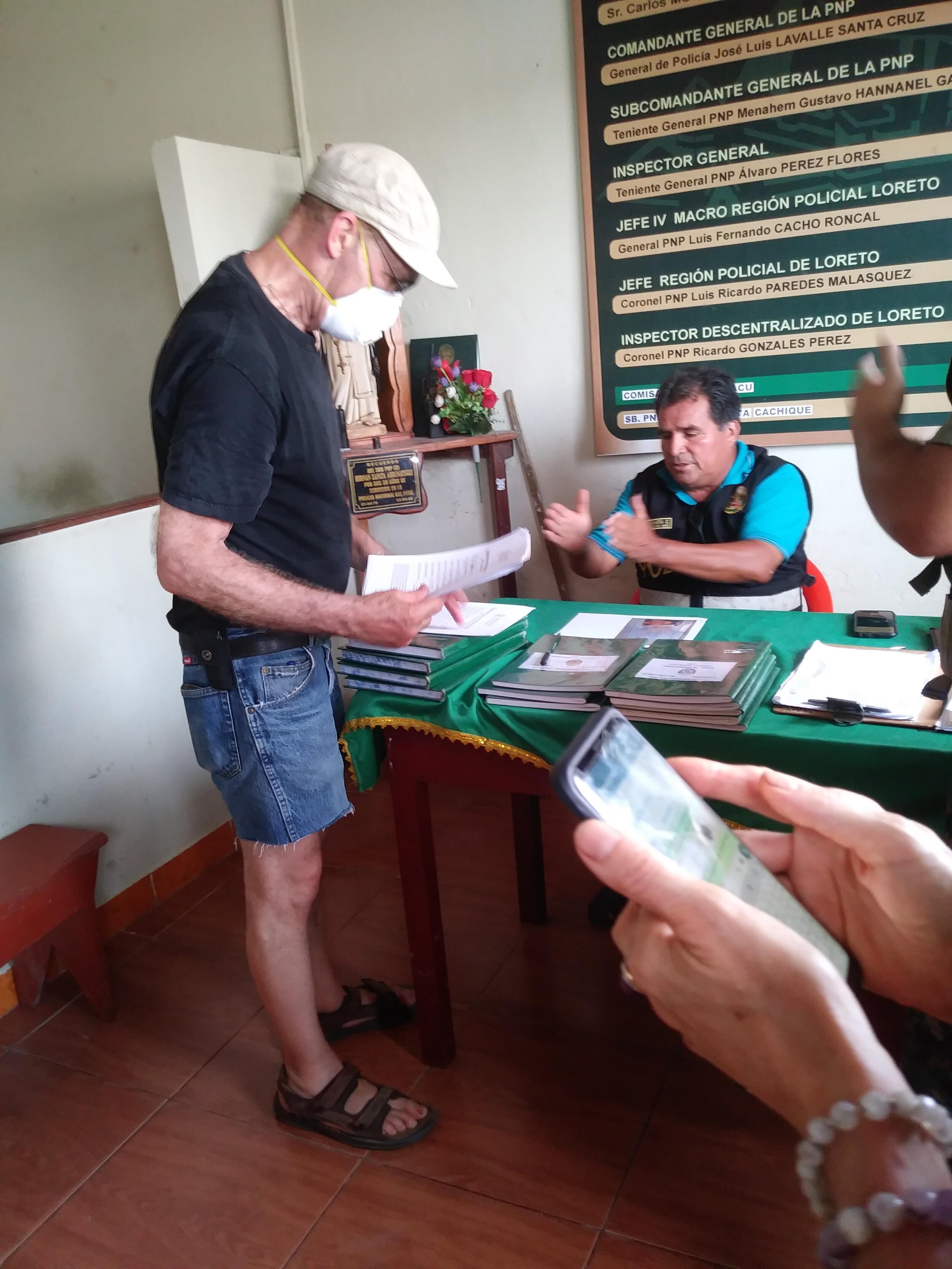
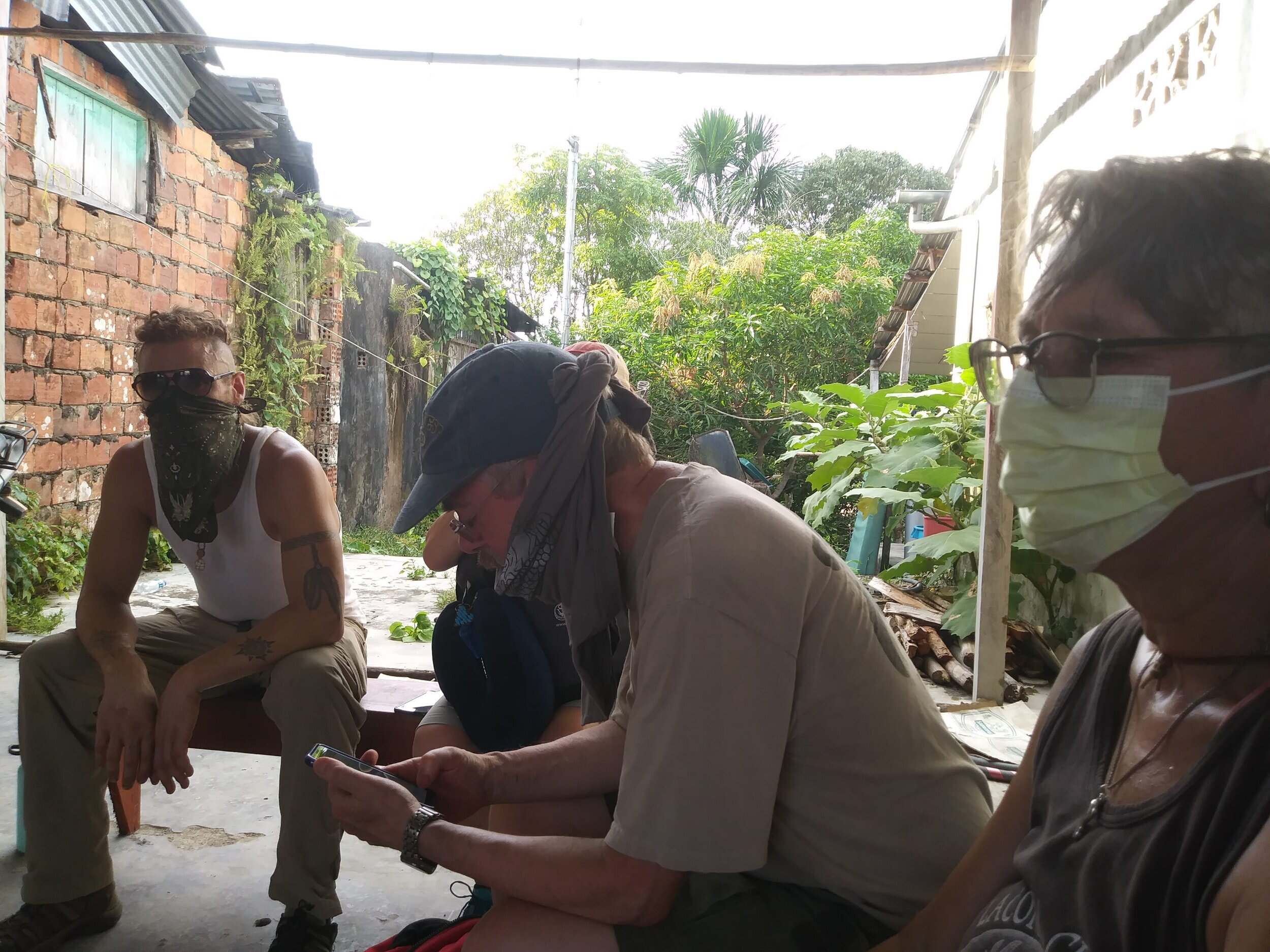
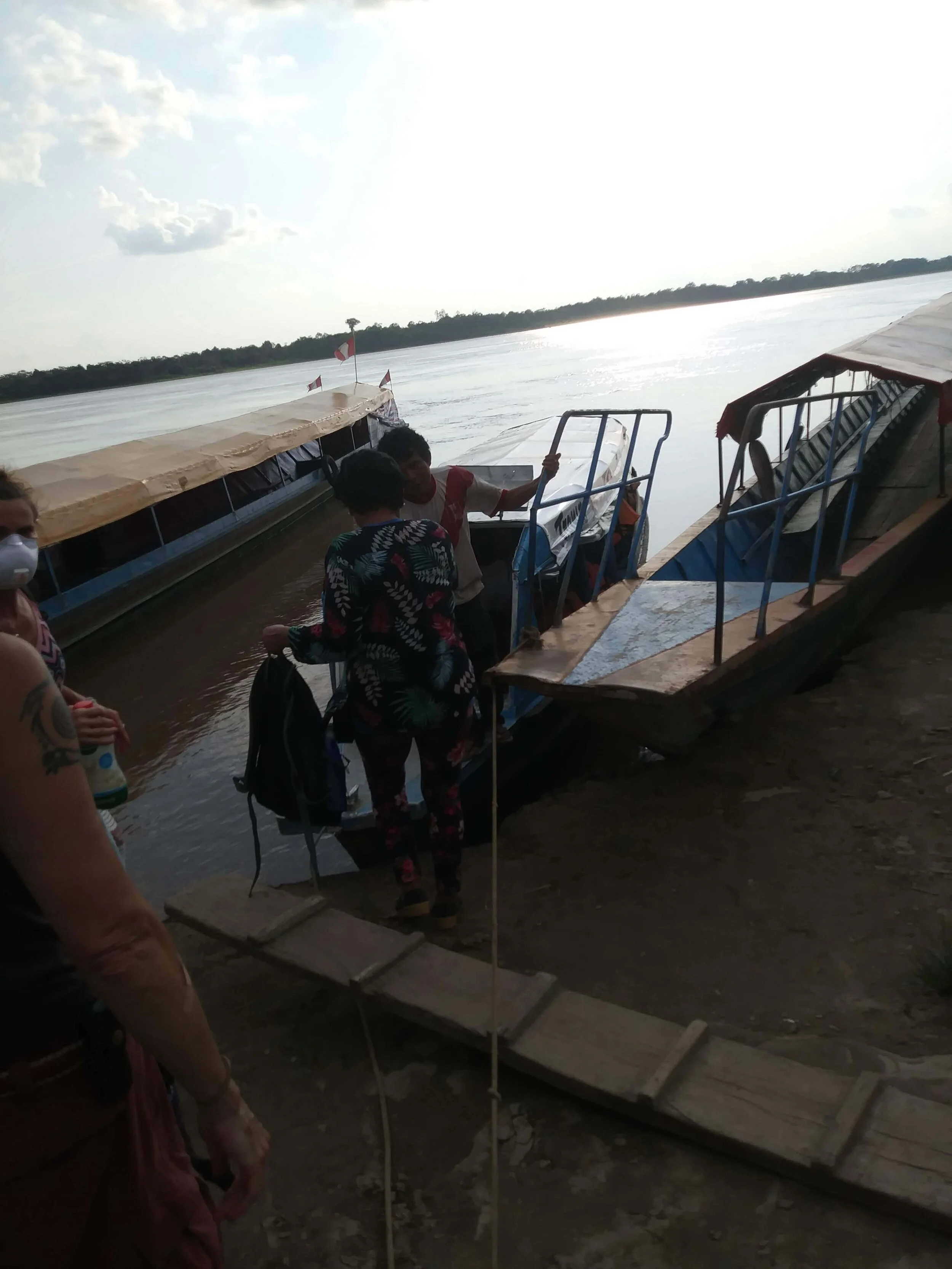
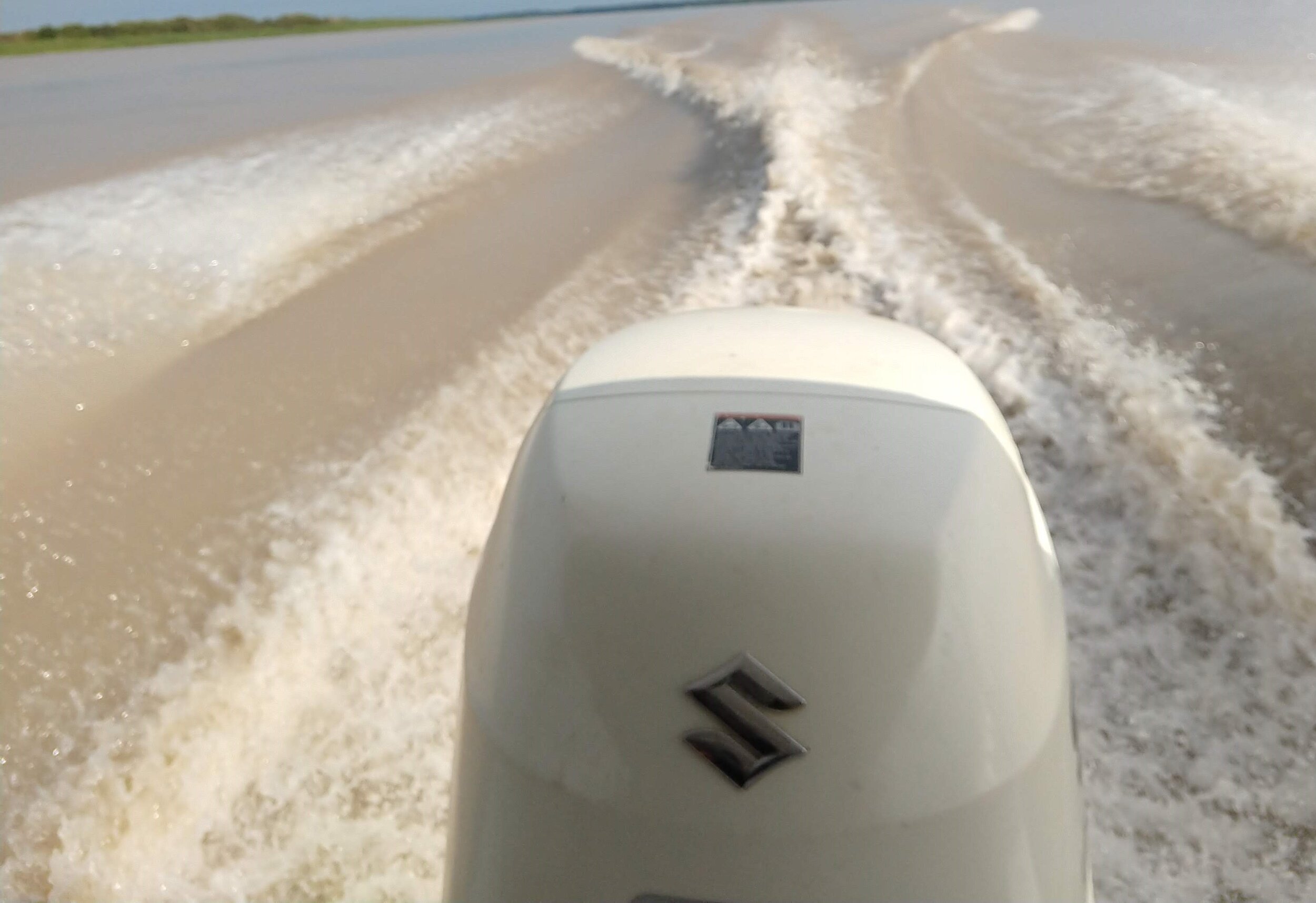
Both of our translators felt that the police were posturing for a bribe, but now seeing that that was unlikely to happen, were more concerned with saving face. So we were marched to the Commissary and placed in a waiting area. Luckily, I had copies of everyones passports in a folder, (the originals being in the hotel safe in Iquitos), which they recopied and made a big show of reviewing and examining in detail as one of the soldiers looked on, apparently on our behalf. After an hour or so, we were released and the soldier escorted us back to our boat, where we thanked him and boarded. Soon, we were headed downstream at full throttle with the mighty Amazon all to ourselves.
Our destination was to be the military dock on the riverbank in Iquitos. Because this was the military, they were expecting us and we were received and treated in a courteous manner. Our documents were examined once again however, and new ones were issued that would give us safe passage back to our hotel.
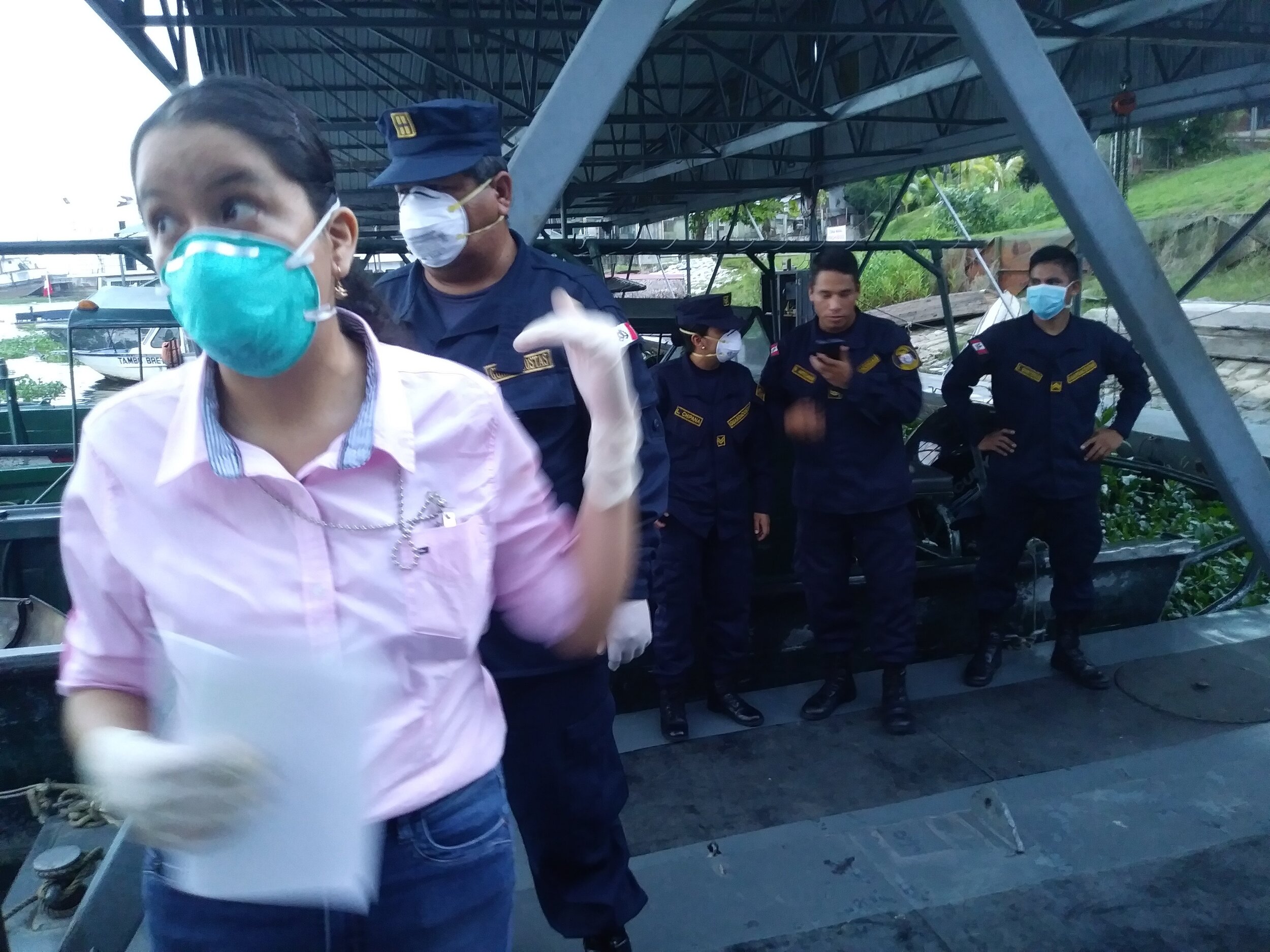

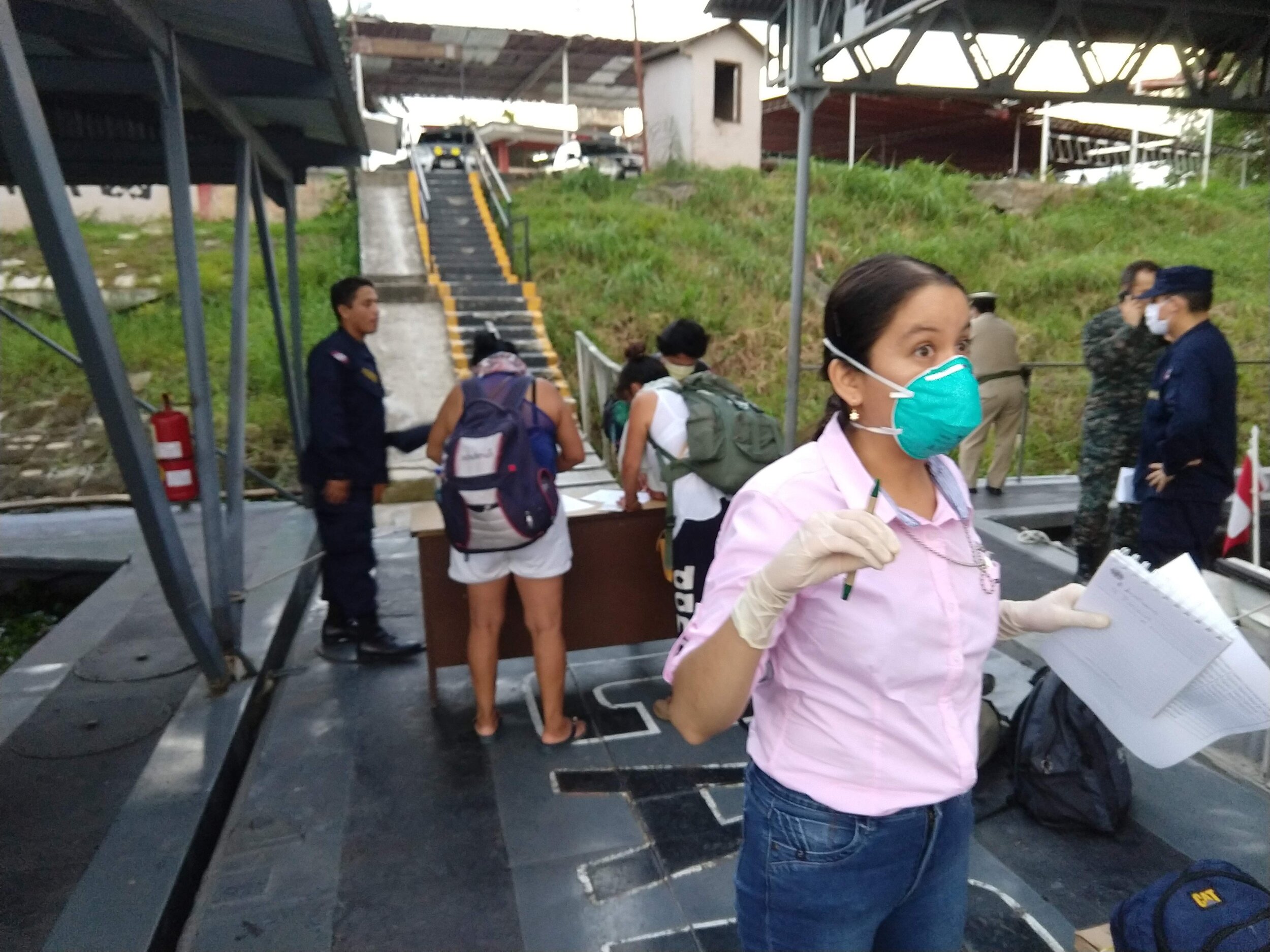
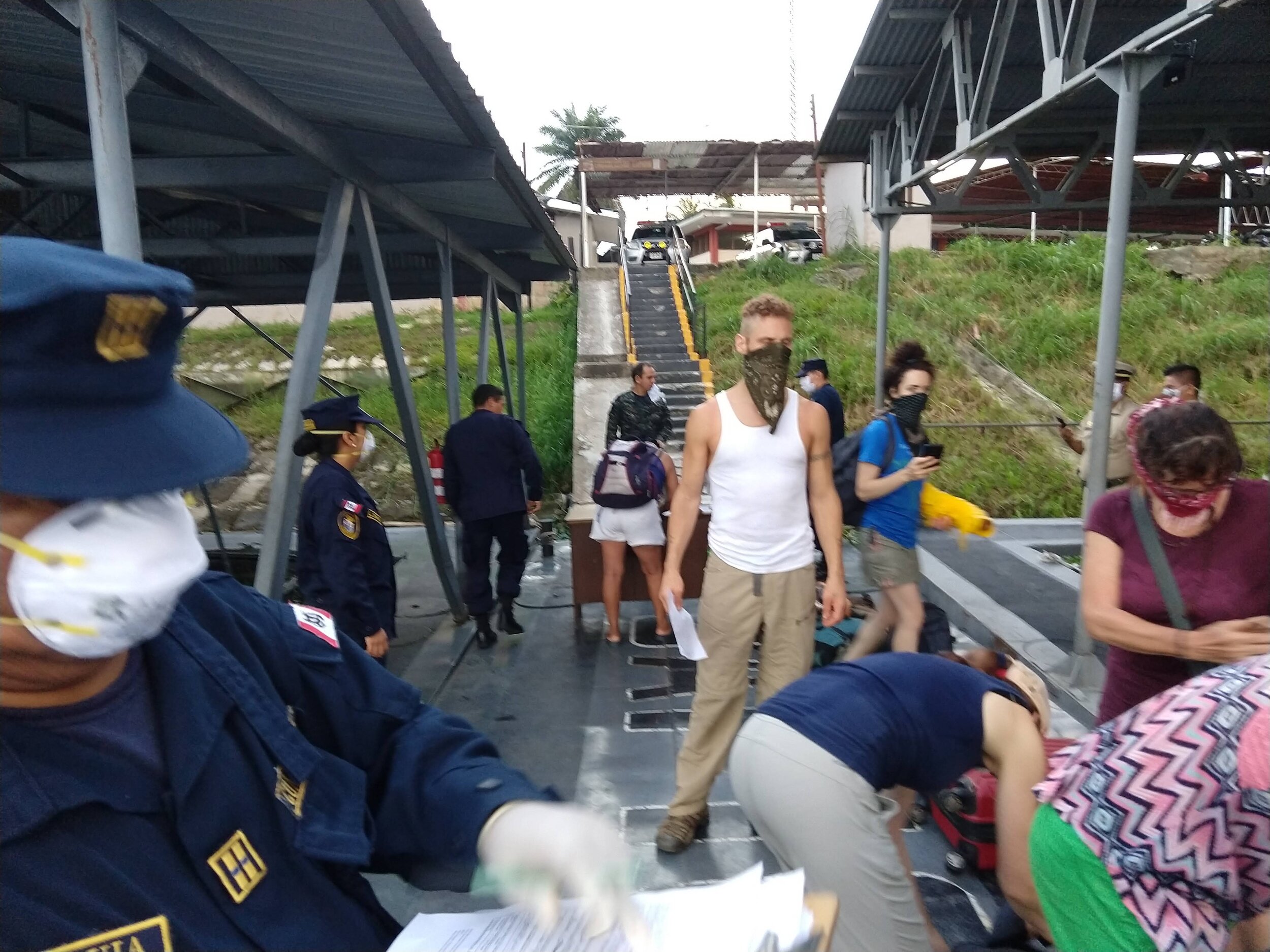
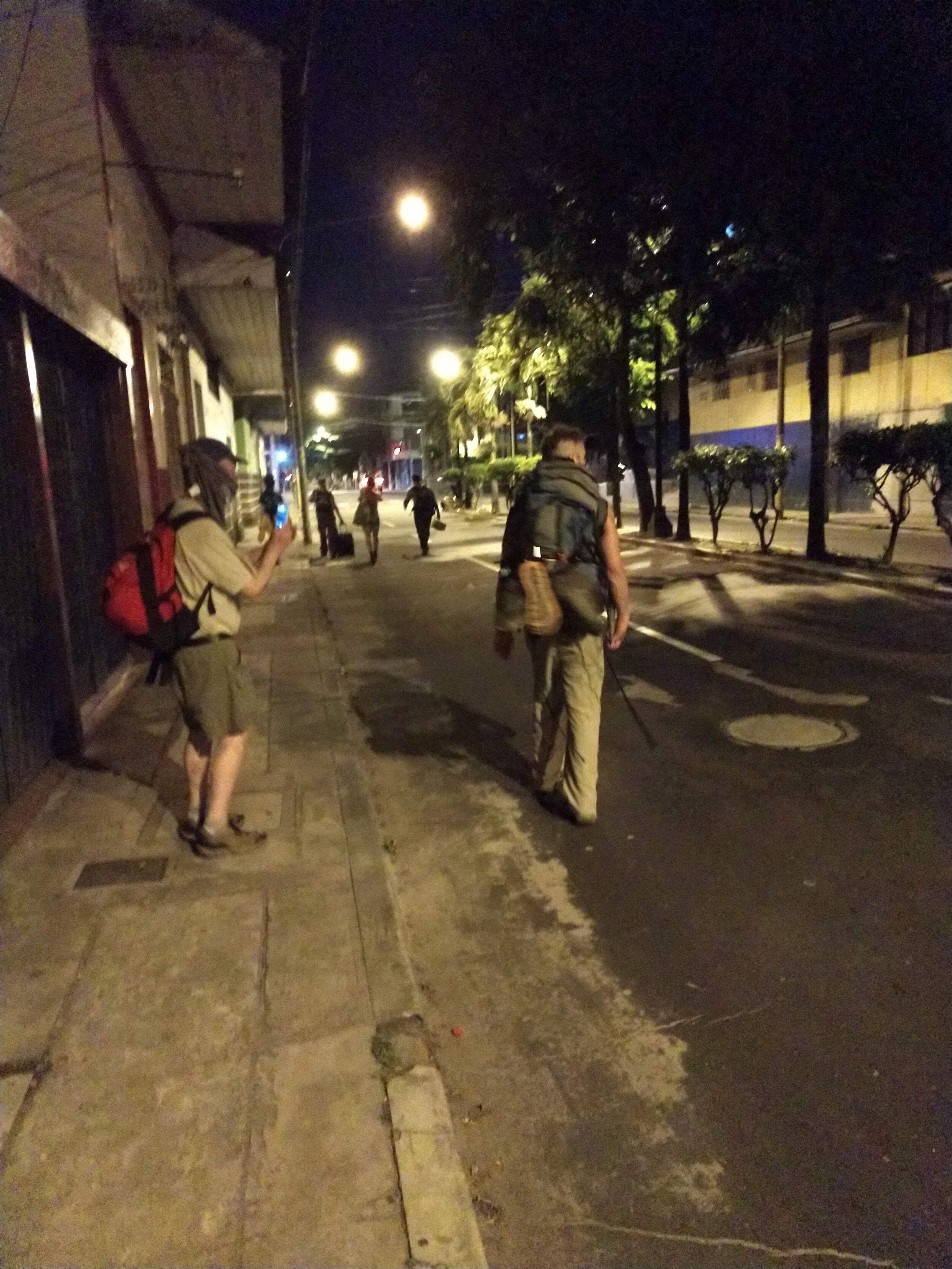



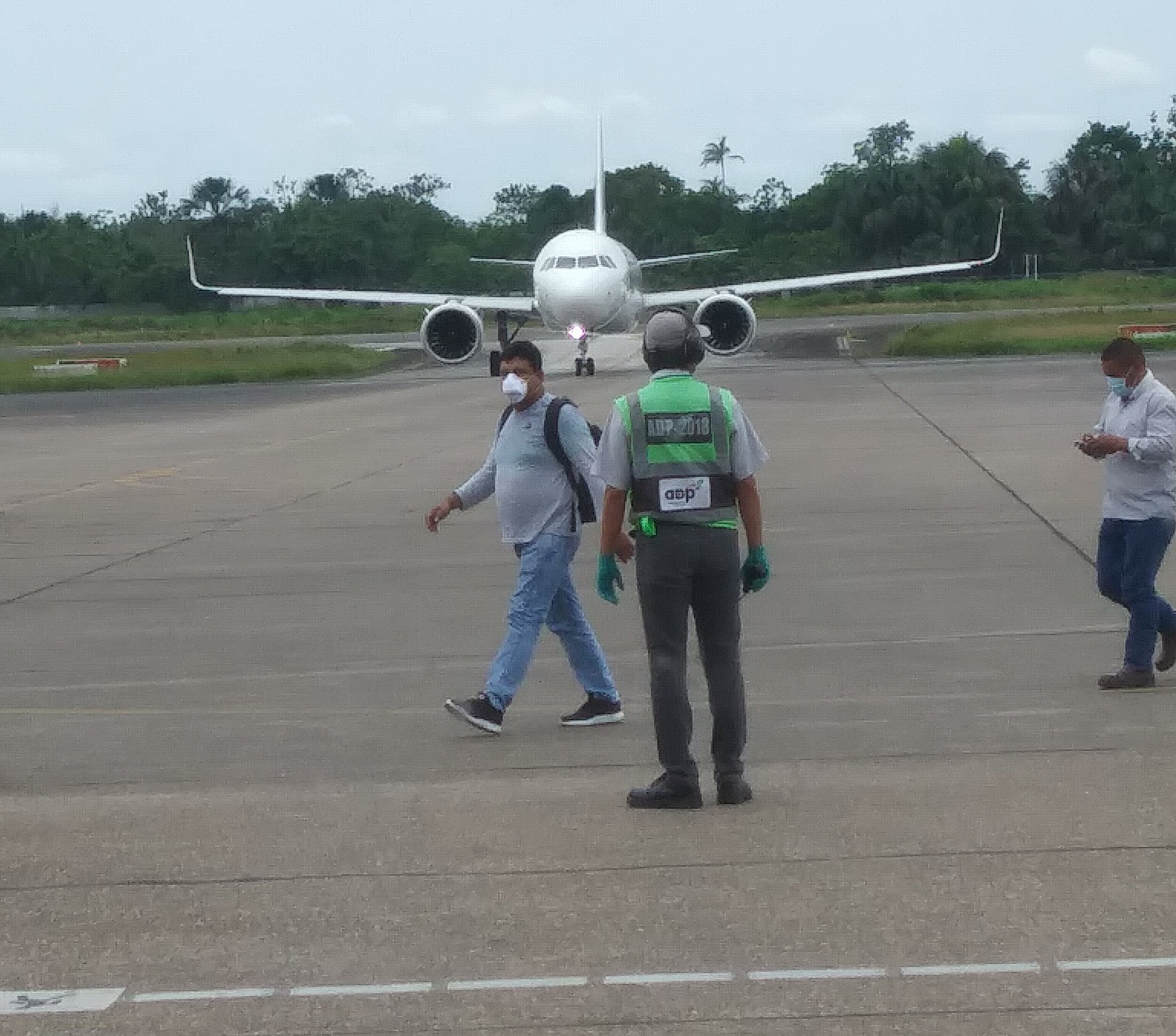
By the time we were processed and released from the base, the sun had gone down. Only a very few moto taxis had a special permit to operate during the quarantine, and we had to drag our luggage along for about a quarter mile before we were able to flag one down. We hired him to bring two loads of luggage to the hotel, there not being space enough to carry any passengers, while we continued to walk the three or so miles to the hotel. By the time we arrived there, we were hungry and tired. We checked into our rooms, then dined on bread and avocados which were all we could manage to find.
That night Miriam and I kept ourselves busy on our respective phones making sure that we secured all the additional documents we would need to travel to and enter the airport the next morning, as well as arrange a police escort so we weren’t unduly detained on the way. By the time we were finished, it was a short night indeed.
We rose early, distributed paperwork to each member of our group, got signatures where necessary, and arranged for taxis. It was a Mad Max ride to the airport, but our motorcycle escort got us there safe and sound. We checked in, got a medical exam and then waited for our plane to arrive.
As the saying goes, “all’s well that ends well”, and though we were returning to a world very different from the one we had left, we were all safe and healthy. Though a visit to the Amazon is always memorable, this one will always be one of the most adventure filled trips we have had, (I hope!).
We thank our hosts, Viejo and Nina, as well as all the wonderful people who made our stay there such a joy, in spite of everything. And I thank our group, who didn’t sign up for this level of drama, but who were excellent companions both in and out of adversity. I know our friendships will endure and look forward to traveling with you again!
-Walk in Beauty…











